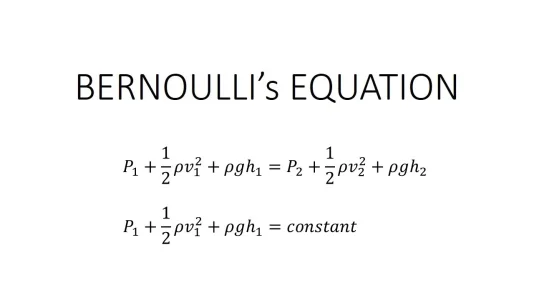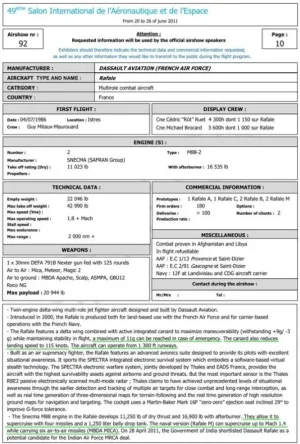I know that several birds are in user tests.Yeah. Although some murmurs about cancellation also.
You are using an out of date browser. It may not display this or other websites correctly.
You should upgrade or use an alternative browser.
You should upgrade or use an alternative browser.
AMCA - Advanced Medium Combat Aircraft (31 Viewers)
- Thread starter fire starter
- Start date
More options
Who Replied?- Joined
- Jul 2, 2024
- Messages
- 828
- Likes
- 2,694
AMCA & Discussion in this Forum
There are two or three things currently under consideration for AMCA to fly by 2035.
1. The frame design is already in progress and India needs no outside help here. Certain very complicated hardware manufacture requires machine tools from outside. That is much easier to get.
2. The Engine with 110/130 KN power. .... ... India cannot build it. The more experienced engine manufacturers, from the outside for a price, will help India to build it. There is no harm in getting the help and TOT now then to wait 5 years and then get it. Costs could be $5 billion (foreign Exchange) if India opts for that. Indian engineers and scientists will do 80% of the work. Additional Indian could cost another $5-8 billion. The outsiders with specific know how will supply the balance but will not part with the technology. That is a big issue right know. If India pays then Indian should have full right to the technology used to build it. This is a sticky point and not easily solved. Political decision making is the key here.
3. Avionics & Weapons can be built in India. Whatever is used and successful for the previous generation like LCA-MK2 should be alright. A few more sophisticated one will have to be imported but no big deal.
Hence for AMCA; decisions made today will impact in next ten years. Remember that China has built two stealth fighters and third one is on way. Hence, India cannot postpone the decision. Truthfully, the Chinese are reverse engineered & copied technology hence could not be classified at the same level as Indian AMCA with OEM technology. Moreover who has seen these Chinese planes in public. Chinese claim more than they deliver.
Bankrupt Pakistan will get some of these stealth fighters from China. Hence, India has to be ready for that. In ten years. Indian economy will exceed $10-12 Trillion in ten years hence can afford to be spendthrift in defence matters.
There are two or three things currently under consideration for AMCA to fly by 2035.
1. The frame design is already in progress and India needs no outside help here. Certain very complicated hardware manufacture requires machine tools from outside. That is much easier to get.
2. The Engine with 110/130 KN power. .... ... India cannot build it. The more experienced engine manufacturers, from the outside for a price, will help India to build it. There is no harm in getting the help and TOT now then to wait 5 years and then get it. Costs could be $5 billion (foreign Exchange) if India opts for that. Indian engineers and scientists will do 80% of the work. Additional Indian could cost another $5-8 billion. The outsiders with specific know how will supply the balance but will not part with the technology. That is a big issue right know. If India pays then Indian should have full right to the technology used to build it. This is a sticky point and not easily solved. Political decision making is the key here.
3. Avionics & Weapons can be built in India. Whatever is used and successful for the previous generation like LCA-MK2 should be alright. A few more sophisticated one will have to be imported but no big deal.
Hence for AMCA; decisions made today will impact in next ten years. Remember that China has built two stealth fighters and third one is on way. Hence, India cannot postpone the decision. Truthfully, the Chinese are reverse engineered & copied technology hence could not be classified at the same level as Indian AMCA with OEM technology. Moreover who has seen these Chinese planes in public. Chinese claim more than they deliver.
Bankrupt Pakistan will get some of these stealth fighters from China. Hence, India has to be ready for that. In ten years. Indian economy will exceed $10-12 Trillion in ten years hence can afford to be spendthrift in defence matters.
- Joined
- Jul 1, 2024
- Messages
- 567
- Likes
- 841
About an engine for AMCA - how much does India spend on engine technology R&D each year? If it is not prepared to invest heavily into an efficient R&D organisation, it is not realistic to think that it will learn how to make viable engines using technology that does not lag decades behind the technology of the major OEM's.
Kaveri 2 looks attainable. Is India turning over a new leaf, doing what is required and spending what is required to get it done?
Kaveri 2 looks attainable. Is India turning over a new leaf, doing what is required and spending what is required to get it done?
Last edited:
- Joined
- Jul 1, 2024
- Messages
- 82
- Likes
- 214
Any performance parameters u heard about?I know that several birds are in user tests.
Naah mate - speculation ad nauseum. One thing for sure - optionally manned.Any performance parameters u heard about?
- Joined
- Jul 2, 2024
- Messages
- 435
- Likes
- 923
The 150 miles without reheat for F35 is because after 150 miles it hit the ground !Internet sources are divided & confusing. This is why i marked AMCA related conclusion in red color.
View attachment 2333
View attachment 2353
1 thing i mentioned correct by mistake "CANNOT SUPERCRUISE"
F35 is only supercruising in a slight descent..... so not the right definition of supercruise.
- Joined
- Jul 2, 2024
- Messages
- 435
- Likes
- 923
- Joined
- Jul 2, 2024
- Messages
- 934
- Likes
- 2,439
Well, you defiitely gave us all a big SHOCKWAVE 
 when you said the following but without adequate diagrams, formula, calculations, etc, increasing our confusion bcoz almost everyone on every forum is talking about thrust, even the news channels & reporting websites.
when you said the following but without adequate diagrams, formula, calculations, etc, increasing our confusion bcoz almost everyone on every forum is talking about thrust, even the news channels & reporting websites.
Q1) But, do we have news that KF-21 has conducted supercruise test?
-------------------------------------------------------------------------------------------------------
Q3) So the ideal solution is a variable cycle engine which will open its high bypass channel at subsonic speed & at supersonic speeds either the channel will be closed fully or some of their air will be diverted to the core. RIGHT?
BUT UNTIL THEN, it seems BPR of 0.3 to 0.45 is already allowing SuCr at M 1.4 to M 1.8
Q4) What is the measurement unit of this "efficiency" & what is difference b/w subsonic & supersonic efficiency? I thought in a an action-reaction engine, eficiency=thrust
Q6) At supersonic airframe speeds also the speed of air inside intake duct before fan & through engine is subsonic. As many of us know some jets use moving ramps, some use convergent-divergent duct to manage air flow. So how does it matter to engine?
Q7) What is your perception boundary value b/w low-high BPR? 0.1/0.2/0.3/0.4?
F-22's F119 BPR is speculated to be 0.3 to 0.45 as per different internet sources.
Rafale's M-88-2 BPR = 0.3
EF-2000's EJ-200 BPR = 0.4
Q8) According to you what should be BPR of new JV engine for AMCA?
-------------------------------------------------------------------------------------------------------
The Drag equation Fd = (1/2) x D x (u^2) x Cd x A
D is the mass density of the fluid
u is the flow velocity relative to the object
A is the reference area
So Drag force is proportional to square of velocity. It is still not that simple.
I shared the Cd graph but Fd graph is different bcoz total drag has contributing types-
1) Parasitic/Profile drag [ a) Viscous pressure/form drag b) skin friction drag ] increase with speed.
2) Lift induced drag [ a) Vortex drag b) Viscous drag ] decrease with speed.
3) Wave drag, independent of viscous effects, transonic speed onwards.
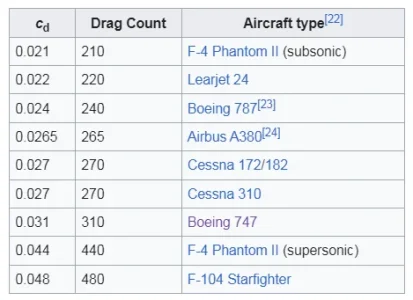
The above Cd are ranging from 0.02 to 0.04 as per aircraft & below Cd is ranging as per speed. This is confusing


(https://commons.wikimedia.org/wiki/File:Qualitive_variation_of_cd_with_mach_number.png)
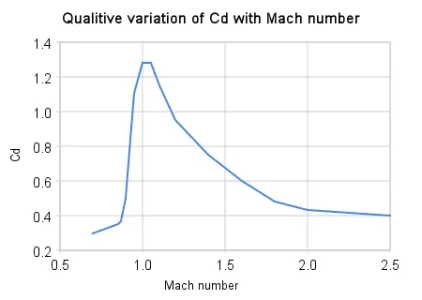
Cd & Fd also varries asper aircraft body design & wing sweep angle


(https://commons.wikimedia.org/wiki/File:Drag_curves_for_aircraft_in_flight.svg)
Q9) The above graphs does not show scale of velocity. So we have to assume that total drag keeps on increasing with speed. So the Cd decreases towards Mach 2 but Fd keeps on increasing. But that doesn't stop Rafale, EF-2000, F-22 to supercruise, nor does it stop the future R&D to increase SuCr speed. Now what is your take on this?
Also its {dry thrust / weight(empty+50%fuel+4 AAMs)} ratio = 0.72 compared to F-22 (0.94 - 0.98)
 ?
?
Such tables aim to find patterns if any in data which taes takes lot of time to gather & arrange it.
IDK their CAP load. I'm considering a clean weight config.
Rafale C empty weight 9.9 T + 50% fuel 2.35 T = 12.25 T; dry 100 KN; T/W=0.832
EF-2000 empty weight 11T + 50% fuel 2.5 T = 13.5 T; dry 120 N; T/W=0.907
Apart from supersonic drag, +0.1 T/W would also add to Ef-2000's benefit.

&So even if amca start using 2×100 kn engines it won't supercruise if the engine loose 90% efficiency after mach 1.
The loss of thrust after mach 1 is very sever, engines can easily loose mote than 50% of thrust after mach 1.
So i have got some very specific fresh queries for you.most important factor for super cruise is engine efficiency not engine thrust.
Agreed, KF-21 is the closest jet in dimensions & design to AMCA.If kf 21 can super cruise with f-414 than most likely amca will also be able to super cruise with f-414.
Q1) But, do we have news that KF-21 has conducted supercruise test?
Q2) Which exact features(plural)? We saw in graph plot that Engine has so many features & sometimes there is a trend, sometimes not. So which features you are pointing to?Anyway F-414 has features suitable for supercruise
-------------------------------------------------------------------------------------------------------
+Increase bypass ratio and you will get high thrust and high subsonic efficiency. Reduce bypass ratio and you will lose efficiency at subsonic speeds but the efficiency will be higher at mach 1+ speeds.
That is why most supercruising planes engine are very low bypass engine.
So idealy F-414 with it's bypass ratio of .3 should allow supercruise if thrust to weight ratio and aerodynamics are favorable.
+(Ideally, the best engine for supercruising plane is a turbojet engine. )
+and bypass ratio of engine.
+F-35 with its current engine may never be able to supercruise even if they increases the dry thrust as the engine will lose most of its efficiency at supersonic speeds since high bypass ratio engines are not optimal for supercruise. F-35 will need a clean sheet engine to achieve supercruise.
+F-35 is also another strike aircraft not optimised for super cruise.
+most important factor for super cruise is engine efficiency not engine thrust.
View attachment 2408
After some Google search, I managed to find this graph. As we can see for turbofan the efficiency is maximum at mach 0.9 after which it rapidly falls. This fall in efficiency is the biggest obstacle for supercruise not the 5-10 % difference in thrust.
Adding more thrust is brute force way of solving a problem of inefficient design.
Q3) So the ideal solution is a variable cycle engine which will open its high bypass channel at subsonic speed & at supersonic speeds either the channel will be closed fully or some of their air will be diverted to the core. RIGHT?
BUT UNTIL THEN, it seems BPR of 0.3 to 0.45 is already allowing SuCr at M 1.4 to M 1.8
Q4) What is the measurement unit of this "efficiency" & what is difference b/w subsonic & supersonic efficiency? I thought in a an action-reaction engine, eficiency=thrust
Q5) How can engine loose 50% thrust or 90% efficiency after Mach-1?So even if amca start using 2×100 kn engines it won't supercruise if the engine loose 90% efficiency after mach 1.
The loss of thrust after mach 1 is very sever, engines can easily loose mote than 50% of thrust after mach 1.
Q6) At supersonic airframe speeds also the speed of air inside intake duct before fan & through engine is subsonic. As many of us know some jets use moving ramps, some use convergent-divergent duct to manage air flow. So how does it matter to engine?
Q7) What is your perception boundary value b/w low-high BPR? 0.1/0.2/0.3/0.4?
F-22's F119 BPR is speculated to be 0.3 to 0.45 as per different internet sources.
Rafale's M-88-2 BPR = 0.3
EF-2000's EJ-200 BPR = 0.4
Q8) According to you what should be BPR of new JV engine for AMCA?
-------------------------------------------------------------------------------------------------------
Indian borders are diversified w.r.t. altitude, high/low pressure regions, cooler high mountains, hotter deserts, moderate plains, humid coasts.Another issue is weather f414 is able deliver desired thrust in indian conditions or not.
I searched & found that Graph for Drag coefficient Cd & Drag Force Fd are different, just like coefficient of friction & friction force = uMg are different.Not exactly even if the drag reduces after Mach 1.5 so does the turbofan efficiency, So a balance is necessary. The optimum supercruise speed for the air-frame depends on drag on the airframe
The Drag equation Fd = (1/2) x D x (u^2) x Cd x A
D is the mass density of the fluid
u is the flow velocity relative to the object
A is the reference area
So Drag force is proportional to square of velocity. It is still not that simple.
I shared the Cd graph but Fd graph is different bcoz total drag has contributing types-
1) Parasitic/Profile drag [ a) Viscous pressure/form drag b) skin friction drag ] increase with speed.
2) Lift induced drag [ a) Vortex drag b) Viscous drag ] decrease with speed.
3) Wave drag, independent of viscous effects, transonic speed onwards.

The above Cd are ranging from 0.02 to 0.04 as per aircraft & below Cd is ranging as per speed. This is confusing



(https://commons.wikimedia.org/wiki/File:Qualitive_variation_of_cd_with_mach_number.png)

Cd & Fd also varries asper aircraft body design & wing sweep angle


(https://commons.wikimedia.org/wiki/File:Drag_curves_for_aircraft_in_flight.svg)
Q9) The above graphs does not show scale of velocity. So we have to assume that total drag keeps on increasing with speed. So the Cd decreases towards Mach 2 but Fd keeps on increasing. But that doesn't stop Rafale, EF-2000, F-22 to supercruise, nor does it stop the future R&D to increase SuCr speed. Now what is your take on this?
Those people have not read any book on engine & aerodynamics. We are here to find the reason behind those numbers.People focus too much on pure numbers without focusing on the reason behind it.
IDK if comparing a giant supersonic transport with a small fighter jet is good or not.Tupolev Tu-144 was casually super cruising at Mach 2 in the 1970s with a measly T/W .44.
Q10) What exact design? AFAIK its trapezoidal wing sweep angle is low creating higher lift but also higher drag.Achieving Super Cruise is not that difficult. F35's inability to supercruise is intentional because it was designed as primarily a strike aircraft (Joint strike fighter project) with secondary air-to-air capability.
Also its {dry thrust / weight(empty+50%fuel+4 AAMs)} ratio = 0.72 compared to F-22 (0.94 - 0.98)
Q11) Why do you think it isKoreans will slowly increase the supercruise speeds in future. KF-21 will be a much better benchmark to compare AMCA instead of a Turkish flying piece of s*** KAAN.
Such tables & entire forums like this are result of secrecy, otherwise none of us had to discuss.The tables is of little use without drag data which is not in public domain.
Such tables aim to find patterns if any in data which taes takes lot of time to gather & arrange it.
Please share your source on that. Such statement could be very tough to find on internet.Each plane has different drag characteristics for example rafale has lower subsonic drag compared to EF- typhoon which resulted in superior air-to-ground performance but higher supersonic drag compared to EF - typoon which results in reduced supercruise speed compared to typhoon.
IDK their CAP load. I'm considering a clean weight config.
Rafale C empty weight 9.9 T + 50% fuel 2.35 T = 12.25 T; dry 100 KN; T/W=0.832
EF-2000 empty weight 11T + 50% fuel 2.5 T = 13.5 T; dry 120 N; T/W=0.907
Apart from supersonic drag, +0.1 T/W would also add to Ef-2000's benefit.
- Joined
- Jul 4, 2024
- Messages
- 39
- Likes
- 170
I will try to answer few of them.Well, you defiitely gave us all a big SHOCKWAVEwhen you said the following but without adequate diagrams, formula, calculations, etc, increasing our confusion bcoz almost everyone on every forum is talking about thrust, even the news channels & reporting websites.
&
So i have got some very specific fresh queries for you.
Agreed, KF-21 is the closest jet in dimensions & design to AMCA.
Q1) But, do we have news that KF-21 has conducted supercruise test?
Q2) Which exact features(plural)? We saw in graph plot that Engine has so many features & sometimes there is a trend, sometimes not. So which features you are pointing to?
-------------------------------------------------------------------------------------------------------
+
+
+
+
+
+
Q3) So the ideal solution is a variable cycle engine which will open its high bypass channel at subsonic speed & at supersonic speeds either the channel will be closed fully or some of their air will be diverted to the core. RIGHT?
BUT UNTIL THEN, it seems BPR of 0.3 to 0.45 is already allowing SuCr at M 1.4 to M 1.8
Q4) What is the measurement unit of this "efficiency" & what is difference b/w subsonic & supersonic efficiency? I thought in a an action-reaction engine, eficiency=thrust
Q5) How can engine loose 50% thrust or 90% efficiency after Mach-1?
Q6) At supersonic airframe speeds also the speed of air inside intake duct before fan & through engine is subsonic. As many of us know some jets use moving ramps, some use convergent-divergent duct to manage air flow. So how does it matter to engine?
Q7) What is your perception boundary value b/w low-high BPR? 0.1/0.2/0.3/0.4?
F-22's F119 BPR is speculated to be 0.3 to 0.45 as per different internet sources.
Rafale's M-88-2 BPR = 0.3
EF-2000's EJ-200 BPR = 0.4
Q8) According to you what should be BPR of new JV engine for AMCA?
-------------------------------------------------------------------------------------------------------
Indian borders are diversified w.r.t. altitude, high/low pressure regions, cooler high mountains, hotter deserts, moderate plains, humid coasts.
I searched & found that Graph for Drag coefficient Cd & Drag Force Fd are different, just like coefficient of friction & friction force = uMg are different.
The Drag equation Fd = (1/2) x D x (u^2) x Cd x A
D is the mass density of the fluid
u is the flow velocity relative to the object
A is the reference area
So Drag force is proportional to square of velocity. It is still not that simple.
I shared the Cd graph but Fd graph is different bcoz total drag has contributing types-
1) Parasitic/Profile drag [ a) Viscous pressure/form drag b) skin friction drag ] increase with speed.
2) Lift induced drag [ a) Vortex drag b) Viscous drag ] decrease with speed.
3) Wave drag, independent of viscous effects, transonic speed onwards.
View attachment 2468
The above Cd are ranging from 0.02 to 0.04 as per aircraft & below Cd is ranging as per speed. This is confusing
(https://commons.wikimedia.org/wiki/File:Qualitive_variation_of_cd_with_mach_number.png)
View attachment 2469
Cd & Fd also varries asper aircraft body design & wing sweep angle
View attachment 2623
View attachment 2467
(https://commons.wikimedia.org/wiki/File:Drag_curves_for_aircraft_in_flight.svg)
Q9) The above graphs does not show scale of velocity. So we have to assume that total drag keeps on increasing with speed. So the Cd decreases towards Mach 2 but Fd keeps on increasing. But that doesn't stop Rafale, EF-2000, F-22 to supercruise, nor does it stop the future R&D to increase SuCr speed. Now what is your take on this?
Those people have not read any book on engine & aerodynamics. We are here to find the reason behind those numbers.
IDK if comparing a giant supersonic transport with a small fighter jet is good or not.
Q10) What exact design? AFAIK its trapezoidal wing sweep angle is low creating higher lift but also higher drag.
Also its {dry thrust / weight(empty+50%fuel+4 AAMs)} ratio = 0.72 compared to F-22 (0.94 - 0.98)
Q11) Why do you think it is?
Such tables & entire forums like this are result of secrecy, otherwise none of us had to discuss.
Such tables aim to find patterns if any in data which taes takes lot of time to gather & arrange it.
Please share your source on that. Such statement could be very tough to find on internet.
IDK their CAP load. I'm considering a clean weight config.
Rafale C empty weight 9.9 T + 50% fuel 2.35 T = 12.25 T; dry 100 KN; T/W=0.832
EF-2000 empty weight 11T + 50% fuel 2.5 T = 13.5 T; dry 120 N; T/W=0.907
Apart from supersonic drag, +0.1 T/W would also add to Ef-2000's benefit.
1)
2) Very low bypass ratio are necessary for super cruise, no super cruising engine has bypass ratio greater than 0.5 but we have no idea weather the fan is optimized for super cruise or net.
3) Definitely, variable cycle engine are claimed to be future for a reason.
4) There are lot of efficiencies involved(compressor efficiency, brayton cycle efficiency, propulsive efficiency etc) each with their own desired parameters. for example at high temperature(such as in India) operation compressor efficiency falls.
(all efficiencies are unit less, cycle efficiency simply means output power/input energy similarly compressor efficiency is isentropic (ideal) work/actual compressor work)
5)This is an example of extreme case such as in high bypaas turbo fan operation at mach 1+.
lot of reason can leads to loss of efficiency at mach 1+. I don't remember all the reasons but the biggest is fans are not optimized for very high speed operation.(smaller the fan better it can be optimised for higher speeds). For detailed explanation i have to read the book which I don't want to.
6)Same as question 5. Whether they use intake ramps or DSI you simply cant design and optimize inlet duct and FAN for every condition. A compromise must be made weather to optimise for subsonic operation or super sonic operation. And as we know high subsonic speeds optimisation are chosen over anything else for obvious reasons.
7) From theory
Bipass ratio increase ~ max velocity decrease<<>> Bipass ratio decrease ~ max velocity increase.
lower better for high speed operation ~~higher better for fuel efficiency ~~now the balance is decided by user requirements.
very low bi-pass ratio like in kaveri can cripple both dry and afterburning thrust.
8) lets assume next gen engine is not a varible cycle engine.
then bi pass-ratio will be around .25-.35 if they are planing to use it for super cruise capable air frame.
otherwise it will be around .6-.8 to reduce IR signature and get better range just like F35.
drag depend on both the velocity, shape and surface roughness.
9)
10) No need to be an aerodynamic or fluid mechanics specialist to realise a fat man( F-35) cant run as fast a thin man(F-22).
F-35 has large thick fuselage, it is optimed to carry 2 X 1000 kg bombs. So if a plane has a body of a bomber it will also perform kinetically simillar to it. Lot of article s are availaible online on this subject (area ruling, fine ness ratio etc) no need to re write them here.
11)
***********
comparing a giant supersonic transport with a small fighter jet is good because it gives us an idea that with enough optimisation plane of any size can supercruise and that it help us in understanding that thrust to weight ratio are not hard limits but they varry. There are many other example on wikipidea article of supercruise. Lockheed F-104 crossed sonic barrier without after burner with dry T/W of only .35 , its wet T/W was .54.
For my Rafale vs EF typhoon comparision lot of literature about their shared history, design , role is availaible online. You wont get the exact values but the design characteristics are self explanatory. Ef typoon's highswept angle, better fineness ratio, canard placement etc all of them are designed to provide better supersonic performance.
Last edited:
- Joined
- Jul 4, 2024
- Messages
- 39
- Likes
- 170
coefficient of drag(Cd) and coefficient of lift (Cl) depends on the shape of the body.
drag overall depends on velocity, shape, surface roughness, density, pressure, altitude, temperature etc and so many other factors.
Pressure, density, temperature, viscosity etc are all interrelated, changing one affects all others.
Drag force or friction force depends on friction factor which indirectly depends on viscosity, but viscosity depends on temperature, pressure, density, fluid properties and altitude (indirectly pressure and temperature). So it is very difficult to calculate aerodynamic drag in ever-changing aerodynamic conditions. So it is better to connect drag with a dimensionless number Cd.
Drag force = Cd X Fluid force/2
Fluid force is Rho X A X V X V
Rho density~ A area ~ v velocity
A X V gives discharge or volumetric flow rate
Rho X A X V gives mass flow rate.
and we know M X V gives momentum and Mass Flow rate in velocity gives force.
I forge t where the 2 comes.

drag overall depends on velocity, shape, surface roughness, density, pressure, altitude, temperature etc and so many other factors.
Pressure, density, temperature, viscosity etc are all interrelated, changing one affects all others.
Drag force or friction force depends on friction factor which indirectly depends on viscosity, but viscosity depends on temperature, pressure, density, fluid properties and altitude (indirectly pressure and temperature). So it is very difficult to calculate aerodynamic drag in ever-changing aerodynamic conditions. So it is better to connect drag with a dimensionless number Cd.
Drag force = Cd X Fluid force/2
Fluid force is Rho X A X V X V
Rho density~ A area ~ v velocity
A X V gives discharge or volumetric flow rate
Rho X A X V gives mass flow rate.
and we know M X V gives momentum and Mass Flow rate in velocity gives force.
I forge t where the 2 comes.
- Joined
- Jul 1, 2024
- Messages
- 109
- Likes
- 860
The answer to whether the F-35 can/cannot supercruise is a topic of great debate.
What exactly is supercruise? In layman terms, Supercruise is defined as the feature/ability of an aircraft to be able to reach supersonic speeds without the use of an after burner. F-35 by this definition actually can supercruise, but for a very short period of time, basically a short dash. The F-35 can sustain over mach 1.2 for about 150 miles, 150 miles into kms => 241.402 kms without AB.
As long as the aircraft has jet-fuel, it will be able to sustain supercruise/supersonic flight with AB, ofcourse before you run out of fuel, incase your aircraft has an IFR probe, then it can refuel itself with the help of a aerial refuelling tanker. So basically, as long as you have fuel, you can supercruise.
But no pilot would be insane to exhaust all his fuel by going supersonic throughout the duration of his flight. Both supersonic flight with AB and even supercruise are fuel intensive though the latter is better because of more efficient consumption of fuel. Supercruise or not, supersonic flight will consume a lot more fuel than subsonic flight.
One thing I don't know if everyone is aware of or not but the maximum ferry range of a fighter such as F-15, F-18, Rafale, F-35, F-22, F-16, Su-30 etc is only achievable in subsonic flight/mainly subsonic. Let's say that your plane is capable of going supersonic and you take off, and you immediately hit the afterburners, while you will cover a vast amount of distance in a short span of time, you will exhaust your fuel much more quicker than in subsonic flight.
In aerodynamics, you can't have both speed and range at once, if you want very high speed then you will have to increase the burn rate of your propellent, but as you increase the burn rate of the propellant, you also greatly increase fuel consumption which in turn results in the onboard plane having less fuel and hence will carry less distance.
The same principle is used in missiles such as meteor which have very long range, why? Because of their ability to throttle back, basically they can control the flow of fuel, unlike conventional missiles like AIM-120, R-77, R-27, SD-10 etc whose motors will burn for a few seconds and the rest of the flight path is only dependent on the kinetic energy that the missile has attained as a result of that boost which it's rocket motor had given it initially.
So conclusion about the F-35's supercruise capabilities: One cannot say that the F-35 cannot super-cruise, it can but not as good as other planes which can maintain supercruise at higher mach speeds and longer durations as compared to F-35. So F-35 has Limited supercruise capabilities, not the absence of supercruise completely.
In my opinion, supercruise is really just a marketing term at least the mach value put forth by LM.
When asking Wikipedia about the definition of Supercruise, this is what we get:
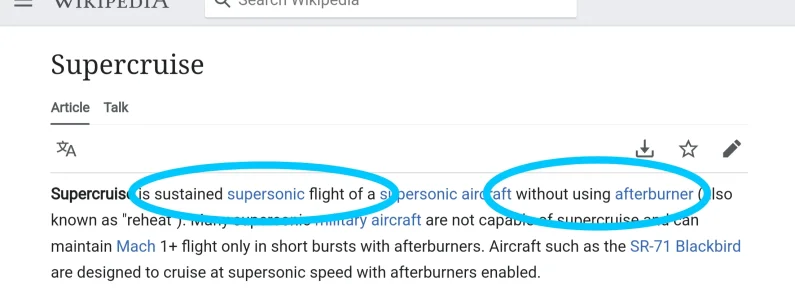
"Supercruise is sustained supersonic flight of a supersonic aircraft without using afterburner (also known as "reheat")."
When an aircraft crosses mach 1, it is said to be in supersonic flight. If LM can set their own definition for supercruise, then we can too.
My definition of Supercruise would be this: Any aircraft that can sustain supersonic flight (Mach 1 or more) with a meaningful payload (in the case of fighter aircraft, this meaningful payload would be weapons such as missiles, bombs, targetting pods, sensors etc). Supercruise is not limited to only combat aircraft that many may aviation enthusiasts may believe, even non-military aircraft can use supercruise, one example being the infamous Concord. I think the entire hue/fuss around supercruise is because of the definition set by LM that is misleading. If AMCA can cross mach 1 without the use of Afterburner (AB) with a decent payload then yes, AMCA can supercruise.
AMCA's supercruise ability depends on the AMCA's powerplant, let's see how that plays out. That said, its not necessarily the thrust that is the defining factor for supercruise, it's the efficiency of the engine which I believe falls significantly after Mach 0.9. I think AMCA Mk-1 will have better S-capabilities than the F-35, it will have limited supercruise capabilities while not completely none at all. MK-2 will have better S-capabilities surpassing both AMCA Mk-1 and F-35 JSF.
What exactly is supercruise? In layman terms, Supercruise is defined as the feature/ability of an aircraft to be able to reach supersonic speeds without the use of an after burner. F-35 by this definition actually can supercruise, but for a very short period of time, basically a short dash. The F-35 can sustain over mach 1.2 for about 150 miles, 150 miles into kms => 241.402 kms without AB.
As long as the aircraft has jet-fuel, it will be able to sustain supercruise/supersonic flight with AB, ofcourse before you run out of fuel, incase your aircraft has an IFR probe, then it can refuel itself with the help of a aerial refuelling tanker. So basically, as long as you have fuel, you can supercruise.
But no pilot would be insane to exhaust all his fuel by going supersonic throughout the duration of his flight. Both supersonic flight with AB and even supercruise are fuel intensive though the latter is better because of more efficient consumption of fuel. Supercruise or not, supersonic flight will consume a lot more fuel than subsonic flight.
One thing I don't know if everyone is aware of or not but the maximum ferry range of a fighter such as F-15, F-18, Rafale, F-35, F-22, F-16, Su-30 etc is only achievable in subsonic flight/mainly subsonic. Let's say that your plane is capable of going supersonic and you take off, and you immediately hit the afterburners, while you will cover a vast amount of distance in a short span of time, you will exhaust your fuel much more quicker than in subsonic flight.
In aerodynamics, you can't have both speed and range at once, if you want very high speed then you will have to increase the burn rate of your propellent, but as you increase the burn rate of the propellant, you also greatly increase fuel consumption which in turn results in the onboard plane having less fuel and hence will carry less distance.
The same principle is used in missiles such as meteor which have very long range, why? Because of their ability to throttle back, basically they can control the flow of fuel, unlike conventional missiles like AIM-120, R-77, R-27, SD-10 etc whose motors will burn for a few seconds and the rest of the flight path is only dependent on the kinetic energy that the missile has attained as a result of that boost which it's rocket motor had given it initially.
So conclusion about the F-35's supercruise capabilities: One cannot say that the F-35 cannot super-cruise, it can but not as good as other planes which can maintain supercruise at higher mach speeds and longer durations as compared to F-35. So F-35 has Limited supercruise capabilities, not the absence of supercruise completely.
In my opinion, supercruise is really just a marketing term at least the mach value put forth by LM.
When asking Wikipedia about the definition of Supercruise, this is what we get:

"Supercruise is sustained supersonic flight of a supersonic aircraft without using afterburner (also known as "reheat")."
When an aircraft crosses mach 1, it is said to be in supersonic flight. If LM can set their own definition for supercruise, then we can too.
My definition of Supercruise would be this: Any aircraft that can sustain supersonic flight (Mach 1 or more) with a meaningful payload (in the case of fighter aircraft, this meaningful payload would be weapons such as missiles, bombs, targetting pods, sensors etc). Supercruise is not limited to only combat aircraft that many may aviation enthusiasts may believe, even non-military aircraft can use supercruise, one example being the infamous Concord. I think the entire hue/fuss around supercruise is because of the definition set by LM that is misleading. If AMCA can cross mach 1 without the use of Afterburner (AB) with a decent payload then yes, AMCA can supercruise.
AMCA's supercruise ability depends on the AMCA's powerplant, let's see how that plays out. That said, its not necessarily the thrust that is the defining factor for supercruise, it's the efficiency of the engine which I believe falls significantly after Mach 0.9. I think AMCA Mk-1 will have better S-capabilities than the F-35, it will have limited supercruise capabilities while not completely none at all. MK-2 will have better S-capabilities surpassing both AMCA Mk-1 and F-35 JSF.
- Joined
- Jul 4, 2024
- Messages
- 39
- Likes
- 170
- Joined
- Jul 4, 2024
- Messages
- 39
- Likes
- 170
Weather super cruise is a marketing terms or not it doesn't matter.The answer to whether the F-35 can/cannot supercruise is a topic of great debate.
What exactly is supercruise? In layman terms, Supercruise is defined as the feature/ability of an aircraft to be able to reach supersonic speeds without the use of an after burner. F-35 by this definition actually can supercruise, but for a very short period of time, basically a short dash. The F-35 can sustain over mach 1.2 for about 150 miles, 150 miles into kms => 241.402 kms without AB.
As long as the aircraft has jet-fuel, it will be able to sustain supercruise/supersonic flight with AB, ofcourse before you run out of fuel, incase your aircraft has an IFR probe, then it can refuel itself with the help of a aerial refuelling tanker. So basically, as long as you have fuel, you can supercruise.
But no pilot would be insane to exhaust all his fuel by going supersonic throughout the duration of his flight. Both supersonic flight with AB and even supercruise are fuel intensive though the latter is better because of more efficient consumption of fuel. Supercruise or not, supersonic flight will consume a lot more fuel than subsonic flight.
One thing I don't know if everyone is aware of or not but the maximum ferry range of a fighter such as F-15, F-18, Rafale, F-35, F-22, F-16, Su-30 etc is only achievable in subsonic flight/mainly subsonic. Let's say that your plane is capable of going supersonic and you take off, and you immediately hit the afterburners, while you will cover a vast amount of distance in a short span of time, you will exhaust your fuel much more quicker than in subsonic flight.
In aerodynamics, you can't have both speed and range at once, if you want very high speed then you will have to increase the burn rate of your propellent, but as you increase the burn rate of the propellant, you also greatly increase fuel consumption which in turn results in the onboard plane having less fuel and hence will carry less distance.
The same principle is used in missiles such as meteor which have very long range, why? Because of their ability to throttle back, basically they can control the flow of fuel, unlike conventional missiles like AIM-120, R-77, R-27, SD-10 etc whose motors will burn for a few seconds and the rest of the flight path is only dependent on the kinetic energy that the missile has attained as a result of that boost which it's rocket motor had given it initially.
So conclusion about the F-35's supercruise capabilities: One cannot say that the F-35 cannot super-cruise, it can but not as good as other planes which can maintain supercruise at higher mach speeds and longer durations as compared to F-35. So F-35 has Limited supercruise capabilities, not the absence of supercruise completely.
In my opinion, supercruise is really just a marketing term at least the mach value put forth by LM.
When asking Wikipedia about the definition of Supercruise, this is what we get:
View attachment 2844
"Supercruise is sustained supersonic flight of a supersonic aircraft without using afterburner (also known as "reheat")."
When an aircraft crosses mach 1, it is said to be in supersonic flight. If LM can set their own definition for supercruise, then we can too.
My definition of Supercruise would be this: Any aircraft that can sustain supersonic flight (Mach 1 or more) with a meaningful payload (in the case of fighter aircraft, this meaningful payload would be weapons such as missiles, bombs, targetting pods, sensors etc). Supercruise is not limited to only combat aircraft that many may aviation enthusiasts may believe, even non-military aircraft can use supercruise, one example being the infamous Concord. I think the entire hue/fuss around supercruise is because of the definition set by LM that is misleading. If AMCA can cross mach 1 without the use of Afterburner (AB) with a decent payload then yes, AMCA can supercruise.
AMCA's supercruise ability depends on the AMCA's powerplant, let's see how that plays out. That said, its not necessarily the thrust that is the defining factor for supercruise, it's the efficiency of the engine which I believe falls significantly after Mach 0.9. I think AMCA Mk-1 will have better S-capabilities than the F-35, it will have limited supercruise capabilities while not completely none at all. MK-2 will have better S-capabilities surpassing both AMCA Mk-1 and F-35 JSF.
The reality is F-35 was primarily designed for subsonic air-to-surface operation. If it can supercruise that is a plus for it, but it was not its primary role. F-35's primary role is SEAD, and for SEAD role it is the best in class in the world right now. No plane came close not even F-22. Even the F-22 doesn't have the range and desired payload capacity comparable to the F35 for SEAD missions.
Super cruising at any speed below Mach 1.4-1.5 is operationally useless. Better to travel at Mach .9 than Mach 1.1 -1.2 and increase drag and fuel consumption exponentially.
Meteor range comes from its air-breathing ram-jet engine. Ordinary missiles have to carry both fuel and oxidizer, but since meteor missile can breathe the desired oxygen from the air it only has to carry fuel which results in more fuel which in turn results in more range but the down side is increased cost.
- Joined
- Jul 1, 2024
- Messages
- 567
- Likes
- 841
I think that if an aircraft cannot sustain supersonic speed on dry thrust without being pointed downhill (eg F-35), it is not capable of supercruise.
- Joined
- Jul 4, 2024
- Messages
- 39
- Likes
- 170
Only production military planes that can practicaly supercruise are F-22 and EF typhoon.
All other gripen,f-35,rafale,J20,Su 57 etc claiming to supercruise are nothing but marketing gimmicks.
Most planes claiming to supercruise use reheat to cross sonic barrier then maintain super sonic speed with dry thrust alone, or sacrificing altitude, or super cruising at mach 1.1-1.2 .
All three methods will satisfy the definition of supercruise but will be operationally useless.
All other gripen,f-35,rafale,J20,Su 57 etc claiming to supercruise are nothing but marketing gimmicks.
Most planes claiming to supercruise use reheat to cross sonic barrier then maintain super sonic speed with dry thrust alone, or sacrificing altitude, or super cruising at mach 1.1-1.2 .
All three methods will satisfy the definition of supercruise but will be operationally useless.
- Joined
- Jul 2, 2024
- Messages
- 435
- Likes
- 923
- Joined
- Jul 2, 2024
- Messages
- 934
- Likes
- 2,439
Having read a book, right from beginning you could have been very specific & given many graphs, diagrams. A pic is worth 1000 words. Anybody can speak generic. The more supporting material you give, the faster the audience will be convinced towards truth.
There are numerous pages on jet engine components. I'll mention only few refernces for now. I'll need 1-2 weeks to go through all related Wiki pages.
After doing basic homework on this EFFICIENCY, i found who talks about Thrust & who about Efficiency & why. I already wrote in a different way-
> All the Efficiencies you mentioned are linked with components obviously. And since beginning i said that Engine's efficiency depends on all its design parameters & operating conditions.
> EFFICIENCY of each engine component does matter bcoz all of them work together to deliver the end result O/p thrust.
But there is no overall engine efficiency. We don't say efficiency of F119 is 90%, EJ-200 is 85%, M-88-2 is 80%, etc.
> It is neither I/p nor O/p. It is a MEASUREMENT TOOL w.r.t. point of reference, Design & Processing Standard to convert I/p to max. O/p.
INPUT => PROCESS => OUTPUT
Air + Fuel => Efficiently (Compress, burn, expand) =>Throw back (Thrust).
Air mass Flow, SFC => weight, BPR, OPR, fuel type, fuel-air mix, TIT, cooling, etc => Thrust
OUTER EFFICIENCY objective = Mileage, max. distance travelled with min. fuel & min. time too. Min. airframe weight but MaxTOW.
INNER EFFICIENCY objective = Optimize weight OPR, BPR, TIT, fuel-air mixing, fuel type, cooling
> EFFICIENCY of components is on R&D, production, overhauling side & has numerous permutauons & combinations. Thrust is end-result O/p, just ONE thing, easier to compare.
It is similar to focussing on bike/car mileage & power rather than bore-stroke, cam-shaft, cylinders, digital fuel injection, carburator, turbocharger, etc, etc, etc.
> Definition of engine performance :-
(https://en.wikipedia.org/wiki/Jet_engine_performance)
"A jet engine performs by converting fuel into THRUST... The meaning of jet engine performance has been phrased as 'the end product that a jet engine company sells and, as such, criteria include thrust and fuel consumption, life, weight, emissions, diameter and cost... Jet engine performance (thrust and fuel consumption) for a pilot is displayed in the cockpit as engine pressure ratio (EPR) and exhaust gas temperature (EGT) or fan speed (N1) and EGT... Thrust and fuel consumption are key performance indicators for a jet engine... Thrust and fuel consumption are combined in a single measure, specific fuel consumption (SFC)... Thrust is easily controlled by regulating airflow and since all of the airflow is pumped by the fan N1 is used for setting thrust... The EGT is a cockpit indicator for fuel flow since the fuel burned in the combustor determines the TIT, which cannot be reliably measured, and EGT is a suitable alternative... EPR & EGT readings can be sometimes misleading... Increased pressure ratio is an improvement to the thermodynamic cycle because combustion at a higher pressure has a reduced entropy rise which is the basic reason for pursuing higher pressure ratios in the jet engine cycle which is known as the Brayton cycle... Thrust is proportional to mass flow which is proportional to total pressure. Jet nozzle pressure and therefore thrust is also proportional to the total pressure at engine entry"
(https://en.wikipedia.org/wiki/Gas_turbine_engine_thrust)
Net Thrust = (M.air + M.fuel)V.exh - (M.air X V.intake)
If the velocity of the jet from a jet engine is equal to sonic velocity, the jet engine's nozzle is said to be choked. If the nozzle is choked, the pressure at the nozzle exit plane is greater than atmospheric pressure, and extra terms must be added to the above equation to account for the pressure thrust... If a turbojet engine has a purely convergent exhaust nozzle and the actual exhaust velocity reaches the speed of sound in air at the exhaust temperature and pressure, the exhaust gas cannot be further accelerated by the nozzle. In such a case, the exhaust gas retains a pressure which is higher than that of the ambient air. This is the source of 'pressure thrust'.
Compressor inlet cooling increases the aerodynamic speed and flow and thrust.
Hence -
> Most Enthusiasts talk about things visible on outside - Thrust, Weight levels (empty, gross, MTOW), T/W ratio, Mileage, speed. Most don't talk about EFFICIENCY bcoz it is Engineering level thing, very mathematical.
> Engineers & scientists talk about everything, especially things on inside like efficiency of smallest things like screws & bolts also.
> Most of World has already moved past individual Attack/Intercepter/Fighter towards multi-role jet, except Russia with Su-34, Mig-31. In any case, R&D continues towards max. distance covered with min. fuel & time. We can call it Mileage or SFC, Supercruise, but objective remains same.
Ultimately today we wan't a SUPERCRUISING MRCA to fly as fast & far as possible with minimum fuel.
Does this mean that TFX Kaan using 2x F110-GE-129 with BPR=0.76 will never supercruise?
brayton cycle efficiency,
propulsive efficiency
Ok, i found sufficient preliminaey things to understand on Wikipedia w/o getting too much into the formulas & equations.
Brayton cycle efficiency,
(https://en.wikipedia.org/wiki/Brayton_cycle)
The O/p of formula of Brayton cycle efficiency is a Percentage but w.r.t. OPR.
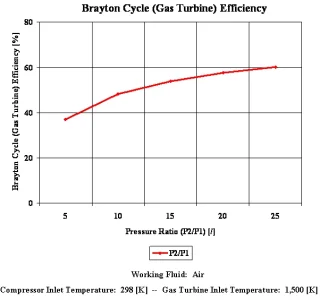
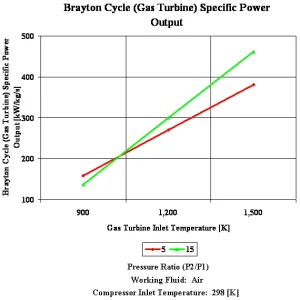
"Since neither the compression nor the expansion can be truly isentropic, losses through the compressor and the expander represent sources of inescapable working inefficiencies. In general, increasing the compression ratio is the most direct way to increase the overall power output of a Brayton system."
And the graph clearly shows P2/P1 is OPR & as it is increased then then SPO (Specific Power O/p) also increases, measured in KW/Kg/s.
Brayton cycle has stages & corresponding components. So Brayton cycle efficiency can be linked to
- OPR for compression,
- TIT (combustor desing- Float-wall, Fuel-air mix ratio; Blade/Film cooling) for heat addition,
- Design for expansion (Turbine blades, exhaust vanes, Counter-rotating spools for air flow control, etc). Just like OPR there is EPR (Engine Pressure ratio).
- May be BPR is linked to heat rejection. EGT (Exhaust Gas Temp.) also.
"The highest gas temperature in the cycle occurs where work transfer to the high pressure turbine (rotor inlet) takes place. This is lower than the highest gas temperature in the engine (combustion zone). The maximum cycle temperature is limited by the turbine materials and required turbine life. This also limits the pressure ratios that can be used in the cycle. For a fixed-turbine inlet temperature, the net work output per cycle increases with the pressure ratio (thus the thermal efficiency) and the net work output. With less work output per cycle, a larger mass flow rate (thus a larger system) is needed to maintain the same power output, which may not be economical."
" increasing the pressure ratio increases the efficiency of the Brayton cycle... increasing the pressure ratio increases the compressor discharge temperature. Since the turbine temperature has a limit determined by metallurgical and life constraints the allowable rise in temperature (fuel added) in the combustor becomes smaller."
Compressor efficiency has OPR or compression ratio, you never focused on this. And compression is part of Brayton cycle.
(https://en.wikipedia.org/wiki/Brayton_cycle#Methods_to_improve_efficiency)
" because the length of the compressor blades becomes progressively smaller in the higher pressure stages a constant running gap, through the compressor, between the blade tips and the engine casing becomes a bigger percentage of the compressor blade height increasing air leakage past the tips. This causes a drop in compressor efficiency, and is most likely to occur in smaller gas turbines (since blades are inherently smaller to begin with)."
Propulsive efficiency
(https://en.wikipedia.org/wiki/Propulsive_efficiency)

"overall propulsion system efficiency 'n' is the efficiency with which the energy contained in a vehicle's fuel is converted into kinetic energy of the vehicle, to accelerate it, or to replace losses due to aerodynamic drag or gravity. n = Nc.Np where
Nc is Cyclic efficiency,
Np is Propulsive efficiency."
"The cycle efficiency is expressed as the percentage of the heat energy in the fuel that is converted to mechanical energy in the engine,
and the propulsive efficiency is expressed as the proportion of the mechanical energy actually used to propel the aircraft. The propulsive efficiency is always less than one, because conservation of momentum requires that the exhaust have some of the kinetic energy, and the propulsive mechanism (whether propeller, jet exhaust, or ducted fan) is never perfectly efficient. It is greatly dependent on exhaust expulsion velocity and airspeed."
"The efficiency of a heat engine relates how much useful work is output for a given amount of heat energy input."
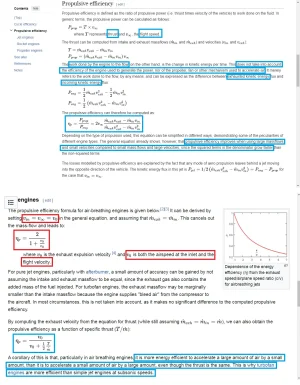
As per last lines marked in blue, at transonic speeds, 2 engines have same thrust, the one with higher BPR is more energy-efficient.
But we should keep in mind that for jet fighters, airspeed at inlet is always subsonic even during supersonic flight velocity.
So materials & cooling put upper limit on TIT; & OPR (# of fan, LPC, HPC stages) contributes to reaching TIT, apart from Fuel-air mix ratio, fuel type, combustor design.
Hence EFFICIENCY = Materials(for high TIT & Eng. T/w) + OPR + Air mass flow + TIT + Fuel-type + Fuel-air ratio + BPR
And that's what i already said w/o having even heard about "Brayton" bcoz in jet engine also there are intake, compression, ignition, exhaust, so their performing components will matter -
BUT the point to note is that these are Design parameters which take in I/p as air+fuel & produce O/p as Thrust. Is there any other O/p coming out of fighter jet?
Why people would come to forums if they can get all the info by self?
Every student/professional tasked with explanation/presentation & every parent has to explain big things in simple ways.
Your contribution is upto you, how much credibility will come to you from members & visitors.
Otherwise someday someone else will do it.
Q5 has been answered now to be connected to high BPR engines & Non-SuCr jets... out of agenda. So a SuCr jet needs engine optimization by keeping its BPR < 0.5
Q6 you say about duct optimization, what exactly?
Only 3 options & these work in both subsonic & supersonic regimes -
1) Ramps control the cross section (CS) area to choke the air & form a convergent-divergent duct @M 1+.
2) DSI duct has constant CS area.
3) Convergent part is there or not, Divergent part has to be there to slow down the air by oblique &/or normal shock.
F-22 uses permant structure convergent-divergent duct.
Rafale seems to use permanent structure divergent-only duct.
EF-2000 looks like permanent structure convergent-divergent, with moving lips.
Su-57 uses ramps
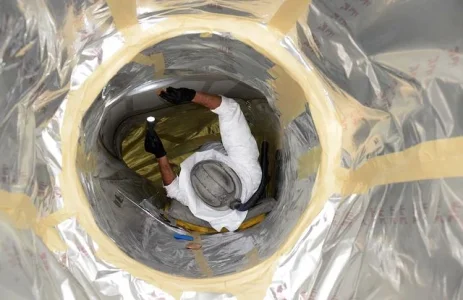
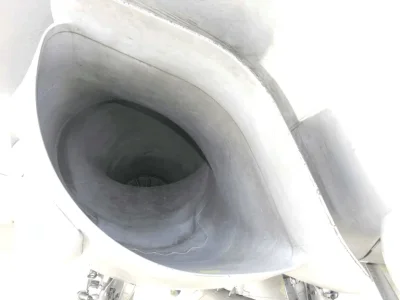
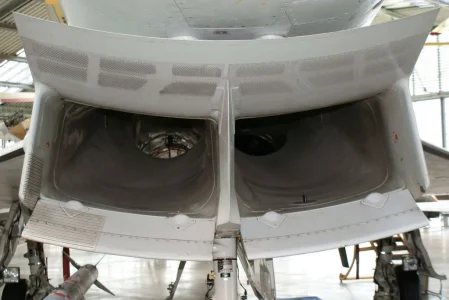
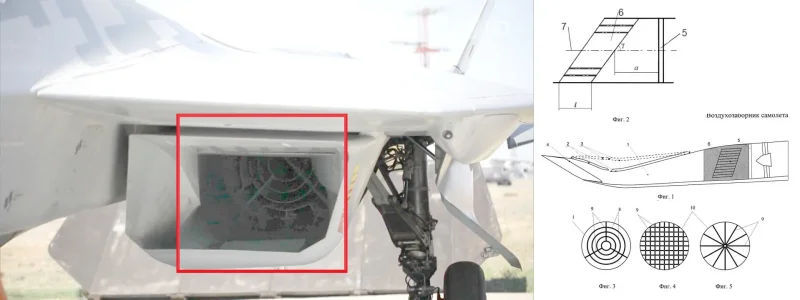
Giving graphs, diagrams or links helps a lot.
BPR alone will not decide max speed. Wing & fuselage design are big contributors also. I already attached multiple graphs.
But F-22's F119 dry SFC in lowest 17.3 gm/KN/s. How to explain that?
And Kaveri's dry/wet thrust is 52/81 KN which is better than F404, M-88-2, RD-33.
I don't follow Kaveri engine so IDK exactly why it failed.
Kaveri BPR = 0.16, it is unusual indeed. In my list i don't see any engine with such low BPR.
Dry thrust SFC = 22.08 gm/KN/s which is not too bad. Most present jets incl. SuCr. ones have SFC range 20-23.
TIT = 1,700 K, also not bad. Most values range 1,600-1,800 K.
Its OPR or Compression ratio is low - 21, but so for AL-31, RD-33MK, RD-93.
Bypass Air can be taken off at various compressor stages for different functions like HVAC, anti-ice, spool cooling, etc & then released back at certain stages. It doesn't always have to be mixed back just after last LPT stage.
In low BPR also, how about increasing OPR to compensate for taking off air from compressor stages?
Recalling, F-22's F119 BPR is speculated to be 0.3 to 0.45 with flat nozzles + Transpiration cooling to reduce plume IRS. F-22 also has dedicated liquid cooling system for entire airframe.
EF-2000's EJ-200 BPR is 0.4
Rafale's M-88-2 BPR is 0.3
Some people said in past on other forums that both these engines have an outer channel to cool engine & reduce plume IRS. Public diagrams & pics may not be exact. M-88-2 also has Kevlar cover around combustion zone.
F-35's F-135 BPR is 0.57
It uses more # of HX (Heat eXchangers) + PAO(polyalphaolefin), a synthetic hydrocarbon oil for cooling.
With MLUs (Mid Life Upgrades) of older jets, some newer sub-systems are added there.


I don't think F-35A with empty weight 13.3 tons is FAT. If it had 2 engines like KF-21, TFX Kaan, J-31/35 then it would have been MRCA w/o VTOL with T/W.int=0.9+ like F-22.
5th gen jet requires additional equipment & compulsary internal components.
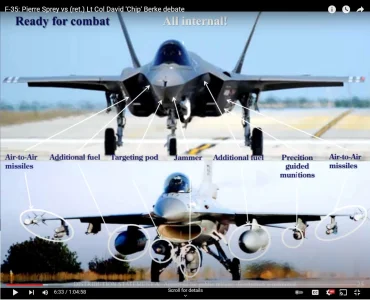

The noticeable thing is a big high sweep angle wing, especially delta, can compensate a lot for low airframe T/W ratio. But Concorde, Tu-144 were clean-config jets w/o any external attachments so far less drag.
How about a Supercruising Cargo jet? I don't mean replacing Concorde passengers with Cargo.
It cannot be compared with today's designs.
Similarly, changing not just BPR but also OPR(# of compressor/turbine stages), fuel type, fuel-air mix ratio, stator vane control, etc can change TIT, thrust, etc.
There are numerous pages on jet engine components. I'll mention only few refernces for now. I'll need 1-2 weeks to go through all related Wiki pages.
After doing basic homework on this EFFICIENCY, i found who talks about Thrust & who about Efficiency & why. I already wrote in a different way-
> All the Efficiencies you mentioned are linked with components obviously. And since beginning i said that Engine's efficiency depends on all its design parameters & operating conditions.
> EFFICIENCY of each engine component does matter bcoz all of them work together to deliver the end result O/p thrust.
But there is no overall engine efficiency. We don't say efficiency of F119 is 90%, EJ-200 is 85%, M-88-2 is 80%, etc.
> It is neither I/p nor O/p. It is a MEASUREMENT TOOL w.r.t. point of reference, Design & Processing Standard to convert I/p to max. O/p.
INPUT => PROCESS => OUTPUT
Air + Fuel => Efficiently (Compress, burn, expand) =>Throw back (Thrust).
Air mass Flow, SFC => weight, BPR, OPR, fuel type, fuel-air mix, TIT, cooling, etc => Thrust
OUTER EFFICIENCY objective = Mileage, max. distance travelled with min. fuel & min. time too. Min. airframe weight but MaxTOW.
INNER EFFICIENCY objective = Optimize weight OPR, BPR, TIT, fuel-air mixing, fuel type, cooling
SO WHY THRUST IS MORE POPULAR THAN EFFICIENCY IS DUE TO FOLLOWING 2 things :-most important factor for super cruise is engine efficiency not engine thrust.
> EFFICIENCY of components is on R&D, production, overhauling side & has numerous permutauons & combinations. Thrust is end-result O/p, just ONE thing, easier to compare.
It is similar to focussing on bike/car mileage & power rather than bore-stroke, cam-shaft, cylinders, digital fuel injection, carburator, turbocharger, etc, etc, etc.
> Definition of engine performance :-
(https://en.wikipedia.org/wiki/Jet_engine_performance)
"A jet engine performs by converting fuel into THRUST... The meaning of jet engine performance has been phrased as 'the end product that a jet engine company sells and, as such, criteria include thrust and fuel consumption, life, weight, emissions, diameter and cost... Jet engine performance (thrust and fuel consumption) for a pilot is displayed in the cockpit as engine pressure ratio (EPR) and exhaust gas temperature (EGT) or fan speed (N1) and EGT... Thrust and fuel consumption are key performance indicators for a jet engine... Thrust and fuel consumption are combined in a single measure, specific fuel consumption (SFC)... Thrust is easily controlled by regulating airflow and since all of the airflow is pumped by the fan N1 is used for setting thrust... The EGT is a cockpit indicator for fuel flow since the fuel burned in the combustor determines the TIT, which cannot be reliably measured, and EGT is a suitable alternative... EPR & EGT readings can be sometimes misleading... Increased pressure ratio is an improvement to the thermodynamic cycle because combustion at a higher pressure has a reduced entropy rise which is the basic reason for pursuing higher pressure ratios in the jet engine cycle which is known as the Brayton cycle... Thrust is proportional to mass flow which is proportional to total pressure. Jet nozzle pressure and therefore thrust is also proportional to the total pressure at engine entry"
(https://en.wikipedia.org/wiki/Gas_turbine_engine_thrust)
Net Thrust = (M.air + M.fuel)V.exh - (M.air X V.intake)
If the velocity of the jet from a jet engine is equal to sonic velocity, the jet engine's nozzle is said to be choked. If the nozzle is choked, the pressure at the nozzle exit plane is greater than atmospheric pressure, and extra terms must be added to the above equation to account for the pressure thrust... If a turbojet engine has a purely convergent exhaust nozzle and the actual exhaust velocity reaches the speed of sound in air at the exhaust temperature and pressure, the exhaust gas cannot be further accelerated by the nozzle. In such a case, the exhaust gas retains a pressure which is higher than that of the ambient air. This is the source of 'pressure thrust'.
Compressor inlet cooling increases the aerodynamic speed and flow and thrust.
Hence -
> Most Enthusiasts talk about things visible on outside - Thrust, Weight levels (empty, gross, MTOW), T/W ratio, Mileage, speed. Most don't talk about EFFICIENCY bcoz it is Engineering level thing, very mathematical.
> Engineers & scientists talk about everything, especially things on inside like efficiency of smallest things like screws & bolts also.
> Most of World has already moved past individual Attack/Intercepter/Fighter towards multi-role jet, except Russia with Su-34, Mig-31. In any case, R&D continues towards max. distance covered with min. fuel & time. We can call it Mileage or SFC, Supercruise, but objective remains same.
Ultimately today we wan't a SUPERCRUISING MRCA to fly as fast & far as possible with minimum fuel.
Right from beginning you emphasized on BPR but you could have mentioned this range specifically.2) Very low bypass ratio are necessary for super cruise, no super cruising engine has bypass ratio greater than 0.5 but we have no idea weather the fan is optimized for super cruise or net.
Does this mean that TFX Kaan using 2x F110-GE-129 with BPR=0.76 will never supercruise?
compressor efficiency,4) There are lot of efficiencies involved(compressor efficiency, brayton cycle efficiency, propulsive efficiencyetc) each with their own desired parameters. for example at high temperature(such as in India) operation compressor efficiency falls.
(all efficiencies are unit less, cycle efficiency simply means output power/input energy similarly compressor efficiency is isentropic (ideal) work/actual compressor work)
brayton cycle efficiency,
propulsive efficiency
Ok, i found sufficient preliminaey things to understand on Wikipedia w/o getting too much into the formulas & equations.
Brayton cycle efficiency,
(https://en.wikipedia.org/wiki/Brayton_cycle)
The O/p of formula of Brayton cycle efficiency is a Percentage but w.r.t. OPR.


"Since neither the compression nor the expansion can be truly isentropic, losses through the compressor and the expander represent sources of inescapable working inefficiencies. In general, increasing the compression ratio is the most direct way to increase the overall power output of a Brayton system."
And the graph clearly shows P2/P1 is OPR & as it is increased then then SPO (Specific Power O/p) also increases, measured in KW/Kg/s.
Brayton cycle has stages & corresponding components. So Brayton cycle efficiency can be linked to
- OPR for compression,
- TIT (combustor desing- Float-wall, Fuel-air mix ratio; Blade/Film cooling) for heat addition,
- Design for expansion (Turbine blades, exhaust vanes, Counter-rotating spools for air flow control, etc). Just like OPR there is EPR (Engine Pressure ratio).
- May be BPR is linked to heat rejection. EGT (Exhaust Gas Temp.) also.
"The highest gas temperature in the cycle occurs where work transfer to the high pressure turbine (rotor inlet) takes place. This is lower than the highest gas temperature in the engine (combustion zone). The maximum cycle temperature is limited by the turbine materials and required turbine life. This also limits the pressure ratios that can be used in the cycle. For a fixed-turbine inlet temperature, the net work output per cycle increases with the pressure ratio (thus the thermal efficiency) and the net work output. With less work output per cycle, a larger mass flow rate (thus a larger system) is needed to maintain the same power output, which may not be economical."
" increasing the pressure ratio increases the efficiency of the Brayton cycle... increasing the pressure ratio increases the compressor discharge temperature. Since the turbine temperature has a limit determined by metallurgical and life constraints the allowable rise in temperature (fuel added) in the combustor becomes smaller."
Compressor efficiency has OPR or compression ratio, you never focused on this. And compression is part of Brayton cycle.
(https://en.wikipedia.org/wiki/Brayton_cycle#Methods_to_improve_efficiency)
" because the length of the compressor blades becomes progressively smaller in the higher pressure stages a constant running gap, through the compressor, between the blade tips and the engine casing becomes a bigger percentage of the compressor blade height increasing air leakage past the tips. This causes a drop in compressor efficiency, and is most likely to occur in smaller gas turbines (since blades are inherently smaller to begin with)."
Propulsive efficiency
(https://en.wikipedia.org/wiki/Propulsive_efficiency)

"overall propulsion system efficiency 'n' is the efficiency with which the energy contained in a vehicle's fuel is converted into kinetic energy of the vehicle, to accelerate it, or to replace losses due to aerodynamic drag or gravity. n = Nc.Np where
Nc is Cyclic efficiency,
Np is Propulsive efficiency."
"The cycle efficiency is expressed as the percentage of the heat energy in the fuel that is converted to mechanical energy in the engine,
and the propulsive efficiency is expressed as the proportion of the mechanical energy actually used to propel the aircraft. The propulsive efficiency is always less than one, because conservation of momentum requires that the exhaust have some of the kinetic energy, and the propulsive mechanism (whether propeller, jet exhaust, or ducted fan) is never perfectly efficient. It is greatly dependent on exhaust expulsion velocity and airspeed."
"The efficiency of a heat engine relates how much useful work is output for a given amount of heat energy input."

As per last lines marked in blue, at transonic speeds, 2 engines have same thrust, the one with higher BPR is more energy-efficient.
But we should keep in mind that for jet fighters, airspeed at inlet is always subsonic even during supersonic flight velocity.
So materials & cooling put upper limit on TIT; & OPR (# of fan, LPC, HPC stages) contributes to reaching TIT, apart from Fuel-air mix ratio, fuel type, combustor design.
Hence EFFICIENCY = Materials(for high TIT & Eng. T/w) + OPR + Air mass flow + TIT + Fuel-type + Fuel-air ratio + BPR
And that's what i already said w/o having even heard about "Brayton" bcoz in jet engine also there are intake, compression, ignition, exhaust, so their performing components will matter -
The parameters which influence thrust & fuel economy of engine are all of its design parameters & operating conditions
The engines can be compared on not just (T/W ratio + Bypass ratio) but all other parameters.
- What about inlet diameter which governs air mass flow, along with air density, altitude & velocity? Higher diameter means lesser RPM bcoz blade-tip cannot cross Mach-1 .
- What about compression/pressure ratio?
- What about # of fan, compressor & turbine stages which affect compression & weight?
- What about engine length? Is there any ideal aspect ratio b/w inlet dia. & engine length?
What creates this difference? Fuel type? Combuster design? Compression/Pressure ratio? Fuel-Air mix ratio?
BUT the point to note is that these are Design parameters which take in I/p as air+fuel & produce O/p as Thrust. Is there any other O/p coming out of fighter jet?
Please be specific, high BPR means how much? 0.5+? If not then why to waste time & effort on "extreme case", something neither part of agenda nor part of AMCA? Mentioning that will only add confusion.5)This is an example of extreme case such as in high bypaas turbo fan operation at mach 1+.
lot of reason can leads to loss of efficiency at mach 1+. I don't remember all the reasons but the biggest is fans are not optimized for very high speed operation.(smaller the fan better it can be optimised for higher speeds).
But you know the topic keywords which you can search online.For detailed explanation i have to read the book which I don't want to.
Why people would come to forums if they can get all the info by self?
Every student/professional tasked with explanation/presentation & every parent has to explain big things in simple ways.
Your contribution is upto you, how much credibility will come to you from members & visitors.
Otherwise someday someone else will do it.
No, Q5 & 6 are different & their answers also you have given different.6)Same as question 5. Whether they use intake ramps or DSI you simply cant design and optimize inlet duct and FAN for every condition. A compromise must be made weather to optimise for subsonic operation or super sonic operation. And as we know high subsonic speeds optimisation are chosen over anything else for obvious reasons.
Q5 has been answered now to be connected to high BPR engines & Non-SuCr jets... out of agenda. So a SuCr jet needs engine optimization by keeping its BPR < 0.5
Q6 you say about duct optimization, what exactly?
Only 3 options & these work in both subsonic & supersonic regimes -
1) Ramps control the cross section (CS) area to choke the air & form a convergent-divergent duct @M 1+.
2) DSI duct has constant CS area.
3) Convergent part is there or not, Divergent part has to be there to slow down the air by oblique &/or normal shock.
F-22 uses permant structure convergent-divergent duct.
Rafale seems to use permanent structure divergent-only duct.
EF-2000 looks like permanent structure convergent-divergent, with moving lips.
Su-57 uses ramps




I asked high-low boundary value (0.1/0.2/0.3/0.4). Anyways, you said <0.5 good for SuCr so i will take that.7) From theory
Bipass ratio increase ~ max velocity decrease<<>> Bipass ratio decrease ~ max velocity increase.
lower better for high speed operation ~~higher better for fuel efficiency ~~now the balance is decided by user requirements.
Giving graphs, diagrams or links helps a lot.
BPR alone will not decide max speed. Wing & fuselage design are big contributors also. I already attached multiple graphs.
But F-22's F119 dry SFC in lowest 17.3 gm/KN/s. How to explain that?
But you said Turbojet with BPR=0 is best for Supercruise.very low bi-pass ratio like in kaveri can cripple both dry and afterburning thrust.
And Kaveri's dry/wet thrust is 52/81 KN which is better than F404, M-88-2, RD-33.
I don't follow Kaveri engine so IDK exactly why it failed.
Kaveri BPR = 0.16, it is unusual indeed. In my list i don't see any engine with such low BPR.
Dry thrust SFC = 22.08 gm/KN/s which is not too bad. Most present jets incl. SuCr. ones have SFC range 20-23.
TIT = 1,700 K, also not bad. Most values range 1,600-1,800 K.
Its OPR or Compression ratio is low - 21, but so for AL-31, RD-33MK, RD-93.
BPR does help in cooling, getting that extra air, but there are other things too.8) lets assume next gen engine is not a varible cycle engine.
then bi pass-ratio will be around .25-.35 if they are planing to use it for super cruise capable air frame.
otherwise it will be around .6-.8 to reduce IR signature and get better range just like F35.
Bypass Air can be taken off at various compressor stages for different functions like HVAC, anti-ice, spool cooling, etc & then released back at certain stages. It doesn't always have to be mixed back just after last LPT stage.
In low BPR also, how about increasing OPR to compensate for taking off air from compressor stages?
Recalling, F-22's F119 BPR is speculated to be 0.3 to 0.45 with flat nozzles + Transpiration cooling to reduce plume IRS. F-22 also has dedicated liquid cooling system for entire airframe.
EF-2000's EJ-200 BPR is 0.4
Rafale's M-88-2 BPR is 0.3
Some people said in past on other forums that both these engines have an outer channel to cool engine & reduce plume IRS. Public diagrams & pics may not be exact. M-88-2 also has Kevlar cover around combustion zone.
F-35's F-135 BPR is 0.57
It uses more # of HX (Heat eXchangers) + PAO(polyalphaolefin), a synthetic hydrocarbon oil for cooling.
With MLUs (Mid Life Upgrades) of older jets, some newer sub-systems are added there.
I already mentioned types of drag, wing sweep angle, with graphs.drag depend on both the velocity, shape and surface roughness.
???????

At least we both agree that F-35 is intentional blunder, but it is due to its poor T/W ratio, bad wing design, only 1 engine due to VTOL.10) No need to be an aerodynamic or fluid mechanics specialist to realise a fat man( F-35) cant run as fast a thin man(F-22).
F-35 has large thick fuselage, it is optimed to carry 2 X 1000 kg bombs. So if a plane has a body of a bomber it will also perform kinetically simillar to it. Lot of article s are availaible online on this subject (area ruling, fine ness ratio etc) no need to re write them here.
I don't think F-35A with empty weight 13.3 tons is FAT. If it had 2 engines like KF-21, TFX Kaan, J-31/35 then it would have been MRCA w/o VTOL with T/W.int=0.9+ like F-22.
5th gen jet requires additional equipment & compulsary internal components.

11)
***********

Why you always speak generic, not specific, even after reading book?comparing a giant supersonic transport with a small fighter jet is good because it gives us an idea that with enough optimisation plane of any size can supercruise and that it help us in understanding that thrust to weight ratio are not hard limits but they varry.
The noticeable thing is a big high sweep angle wing, especially delta, can compensate a lot for low airframe T/W ratio. But Concorde, Tu-144 were clean-config jets w/o any external attachments so far less drag.
How about a Supercruising Cargo jet? I don't mean replacing Concorde passengers with Cargo.
yeah, saw them long back. From that page only i got the 1st Cd graph.There are many other example on wikipidea article of supercruise.
F-104 was very slim trim jet like a dart or rocket with very short wings. The maximum speed without afterburning was Mach 1.05, some say 1.1Lockheed F-104 crossed sonic barrier without after burner with dry T/W of only .35 , its wet T/W was .54.
It cannot be compared with today's designs.
I already said that.coefficient of drag(Cd) and coefficient of lift (Cl) depends on the shape of the body.
drag overall depends on velocity, shape, surface roughness, density, pressure, altitude, temperature etc and so many other factors.
Pressure, density, temperature, viscosity etc are all interrelated, changing one affects all others.
Drag force or friction force depends on friction factor which indirectly depends on viscosity, but viscosity depends on temperature, pressure, density, fluid properties and altitude (indirectly pressure and temperature). So it is very difficult to calculate aerodynamic drag in ever-changing aerodynamic conditions. So it is better to connect drag with a dimensionless number Cd.
I shared the Cd graph but Fd graph is different bcoz total drag has contributing types-
1) Parasitic/Profile drag [ a) Viscous pressure/form drag b) skin friction drag ] increase with speed.
2) Lift induced drag [ a) Vortex drag b) Viscous drag ] decrease with speed.
3) Wave drag, independent of viscous effects, transonic speed onwards.
Cd & Fd also varries as per aircraft body design & wing sweep angle
Similarly, changing not just BPR but also OPR(# of compressor/turbine stages), fuel type, fuel-air mix ratio, stator vane control, etc can change TIT, thrust, etc.
- Joined
- Jul 4, 2024
- Messages
- 39
- Likes
- 170
Brother, just relax.Having read a book, right from beginning you could have been very specific & given many graphs, diagrams. A pic is worth 1000 words. Anybody can speak generic. The more supporting material you give, the faster the audience will be convinced towards truth.
There are numerous pages on jet engine components. I'll mention only few refernces for now. I'll need 1-2 weeks to go through all related Wiki pages.
After doing basic homework on this EFFICIENCY, i found who talks about Thrust & who about Efficiency & why. I already wrote in a different way-
> All the Efficiencies you mentioned are linked with components obviously. And since beginning i said that Engine's efficiency depends on all its design parameters & operating conditions.
> EFFICIENCY of each engine component does matter bcoz all of them work together to deliver the end result O/p thrust.
But there is no overall engine efficiency. We don't say efficiency of F119 is 90%, EJ-200 is 85%, M-88-2 is 80%, etc.
> It is neither I/p nor O/p. It is a MEASUREMENT TOOL w.r.t. point of reference, Design & Processing Standard to convert I/p to max. O/p.
INPUT => PROCESS => OUTPUT
Air + Fuel => Efficiently (Compress, burn, expand) =>Throw back (Thrust).
Air mass Flow, SFC => weight, BPR, OPR, fuel type, fuel-air mix, TIT, cooling, etc => Thrust
OUTER EFFICIENCY objective = Mileage, max. distance travelled with min. fuel & min. time too. Min. airframe weight but MaxTOW.
INNER EFFICIENCY objective = Optimize weight OPR, BPR, TIT, fuel-air mixing, fuel type, cooling
SO WHY THRUST IS MORE POPULAR THAN EFFICIENCY IS DUE TO FOLLOWING 2 things :-
> EFFICIENCY of components is on R&D, production, overhauling side & has numerous permutauons & combinations. Thrust is end-result O/p, just ONE thing, easier to compare.
It is similar to focussing on bike/car mileage & power rather than bore-stroke, cam-shaft, cylinders, digital fuel injection, carburator, turbocharger, etc, etc, etc.
> Definition of engine performance :-
(https://en.wikipedia.org/wiki/Jet_engine_performance)
"A jet engine performs by converting fuel into THRUST... The meaning of jet engine performance has been phrased as 'the end product that a jet engine company sells and, as such, criteria include thrust and fuel consumption, life, weight, emissions, diameter and cost... Jet engine performance (thrust and fuel consumption) for a pilot is displayed in the cockpit as engine pressure ratio (EPR) and exhaust gas temperature (EGT) or fan speed (N1) and EGT... Thrust and fuel consumption are key performance indicators for a jet engine... Thrust and fuel consumption are combined in a single measure, specific fuel consumption (SFC)... Thrust is easily controlled by regulating airflow and since all of the airflow is pumped by the fan N1 is used for setting thrust... The EGT is a cockpit indicator for fuel flow since the fuel burned in the combustor determines the TIT, which cannot be reliably measured, and EGT is a suitable alternative... EPR & EGT readings can be sometimes misleading... Increased pressure ratio is an improvement to the thermodynamic cycle because combustion at a higher pressure has a reduced entropy rise which is the basic reason for pursuing higher pressure ratios in the jet engine cycle which is known as the Brayton cycle... Thrust is proportional to mass flow which is proportional to total pressure. Jet nozzle pressure and therefore thrust is also proportional to the total pressure at engine entry"
(https://en.wikipedia.org/wiki/Gas_turbine_engine_thrust)
Net Thrust = (M.air + M.fuel)V.exh - (M.air X V.intake)
If the velocity of the jet from a jet engine is equal to sonic velocity, the jet engine's nozzle is said to be choked. If the nozzle is choked, the pressure at the nozzle exit plane is greater than atmospheric pressure, and extra terms must be added to the above equation to account for the pressure thrust... If a turbojet engine has a purely convergent exhaust nozzle and the actual exhaust velocity reaches the speed of sound in air at the exhaust temperature and pressure, the exhaust gas cannot be further accelerated by the nozzle. In such a case, the exhaust gas retains a pressure which is higher than that of the ambient air. This is the source of 'pressure thrust'.
Compressor inlet cooling increases the aerodynamic speed and flow and thrust.
Hence -
> Most Enthusiasts talk about things visible on outside - Thrust, Weight levels (empty, gross, MTOW), T/W ratio, Mileage, speed. Most don't talk about EFFICIENCY bcoz it is Engineering level thing, very mathematical.
> Engineers & scientists talk about everything, especially things on inside like efficiency of smallest things like screws & bolts also.
> Most of World has already moved past individual Attack/Intercepter/Fighter towards multi-role jet, except Russia with Su-34, Mig-31. In any case, R&D continues towards max. distance covered with min. fuel & time. We can call it Mileage or SFC, Supercruise, but objective remains same.
Ultimately today we wan't a SUPERCRUISING MRCA to fly as fast & far as possible with minimum fuel.
Right from beginning you emphasized on BPR but you could have mentioned this range specifically.
Does this mean that TFX Kaan using 2x F110-GE-129 with BPR=0.76 will never supercruise?
compressor efficiency,
brayton cycle efficiency,
propulsive efficiency
Ok, i found sufficient preliminaey things to understand on Wikipedia w/o getting too much into the formulas & equations.
Brayton cycle efficiency,
(https://en.wikipedia.org/wiki/Brayton_cycle)
The O/p of formula of Brayton cycle efficiency is a Percentage but w.r.t. OPR.
View attachment 2747
View attachment 2749
"Since neither the compression nor the expansion can be truly isentropic, losses through the compressor and the expander represent sources of inescapable working inefficiencies. In general, increasing the compression ratio is the most direct way to increase the overall power output of a Brayton system."
And the graph clearly shows P2/P1 is OPR & as it is increased then then SPO (Specific Power O/p) also increases, measured in KW/Kg/s.
Brayton cycle has stages & corresponding components. So Brayton cycle efficiency can be linked to
- OPR for compression,
- TIT (combustor desing- Float-wall, Fuel-air mix ratio; Blade/Film cooling) for heat addition,
- Design for expansion (Turbine blades, exhaust vanes, Counter-rotating spools for air flow control, etc). Just like OPR there is EPR (Engine Pressure ratio).
- May be BPR is linked to heat rejection. EGT (Exhaust Gas Temp.) also.
"The highest gas temperature in the cycle occurs where work transfer to the high pressure turbine (rotor inlet) takes place. This is lower than the highest gas temperature in the engine (combustion zone). The maximum cycle temperature is limited by the turbine materials and required turbine life. This also limits the pressure ratios that can be used in the cycle. For a fixed-turbine inlet temperature, the net work output per cycle increases with the pressure ratio (thus the thermal efficiency) and the net work output. With less work output per cycle, a larger mass flow rate (thus a larger system) is needed to maintain the same power output, which may not be economical."
" increasing the pressure ratio increases the efficiency of the Brayton cycle... increasing the pressure ratio increases the compressor discharge temperature. Since the turbine temperature has a limit determined by metallurgical and life constraints the allowable rise in temperature (fuel added) in the combustor becomes smaller."
Compressor efficiency has OPR or compression ratio, you never focused on this. And compression is part of Brayton cycle.
(https://en.wikipedia.org/wiki/Brayton_cycle#Methods_to_improve_efficiency)
" because the length of the compressor blades becomes progressively smaller in the higher pressure stages a constant running gap, through the compressor, between the blade tips and the engine casing becomes a bigger percentage of the compressor blade height increasing air leakage past the tips. This causes a drop in compressor efficiency, and is most likely to occur in smaller gas turbines (since blades are inherently smaller to begin with)."
Propulsive efficiency
(https://en.wikipedia.org/wiki/Propulsive_efficiency)
View attachment 3037
"overall propulsion system efficiency 'n' is the efficiency with which the energy contained in a vehicle's fuel is converted into kinetic energy of the vehicle, to accelerate it, or to replace losses due to aerodynamic drag or gravity. n = Nc.Np where
Nc is Cyclic efficiency,
Np is Propulsive efficiency."
"The cycle efficiency is expressed as the percentage of the heat energy in the fuel that is converted to mechanical energy in the engine,
and the propulsive efficiency is expressed as the proportion of the mechanical energy actually used to propel the aircraft. The propulsive efficiency is always less than one, because conservation of momentum requires that the exhaust have some of the kinetic energy, and the propulsive mechanism (whether propeller, jet exhaust, or ducted fan) is never perfectly efficient. It is greatly dependent on exhaust expulsion velocity and airspeed."
"The efficiency of a heat engine relates how much useful work is output for a given amount of heat energy input."
View attachment 2911
As per last lines marked in blue, at transonic speeds, 2 engines have same thrust, the one with higher BPR is more energy-efficient.
But we should keep in mind that for jet fighters, airspeed at inlet is always subsonic even during supersonic flight velocity.
So materials & cooling put upper limit on TIT; & OPR (# of fan, LPC, HPC stages) contributes to reaching TIT, apart from Fuel-air mix ratio, fuel type, combustor design.
Hence EFFICIENCY = Materials(for high TIT & Eng. T/w) + OPR + Air mass flow + TIT + Fuel-type + Fuel-air ratio + BPR
And that's what i already said w/o having even heard about "Brayton" bcoz in jet engine also there are intake, compression, ignition, exhaust, so their performing components will matter -
BUT the point to note is that these are Design parameters which take in I/p as air+fuel & produce O/p as Thrust. Is there any other O/p coming out of fighter jet?
Please be specific, high BPR means how much? 0.5+? If not then why to waste time & effort on "extreme case", something neither part of agenda nor part of AMCA? Mentioning that will only add confusion.
But you know the topic keywords which you can search online.
Why people would come to forums if they can get all the info by self?
Every student/professional tasked with explanation/presentation & every parent has to explain big things in simple ways.
Your contribution is upto you, how much credibility will come to you from members & visitors.
Otherwise someday someone else will do it.
No, Q5 & 6 are different & their answers also you have given different.
Q5 has been answered now to be connected to high BPR engines & Non-SuCr jets... out of agenda. So a SuCr jet needs engine optimization by keeping its BPR < 0.5
Q6 you say about duct optimization, what exactly?
Only 3 options & these work in both subsonic & supersonic regimes -
1) Ramps control the cross section (CS) area to choke the air & form a convergent-divergent duct @M 1+.
2) DSI duct has constant CS area.
3) Convergent part is there or not, Divergent part has to be there to slow down the air by oblique &/or normal shock.
F-22 uses permant structure convergent-divergent duct.
Rafale seems to use permanent structure divergent-only duct.
EF-2000 looks like permanent structure convergent-divergent, with moving lips.
Su-57 uses ramps
View attachment 2736
View attachment 2735
View attachment 2734
View attachment 2737
I asked high-low boundary value (0.1/0.2/0.3/0.4). Anyways, you said <0.5 good for SuCr so i will take that.
Giving graphs, diagrams or links helps a lot.
BPR alone will not decide max speed. Wing & fuselage design are big contributors also. I already attached multiple graphs.
But F-22's F119 dry SFC in lowest 17.3 gm/KN/s. How to explain that?
But you said Turbojet with BPR=0 is best for Supercruise.
And Kaveri's dry/wet thrust is 52/81 KN which is better than F404, M-88-2, RD-33.
I don't follow Kaveri engine so IDK exactly why it failed.
Kaveri BPR = 0.16, it is unusual indeed. In my list i don't see any engine with such low BPR.
Dry thrust SFC = 22.08 gm/KN/s which is not too bad. Most present jets incl. SuCr. ones have SFC range 20-23.
TIT = 1,700 K, also not bad. Most values range 1,600-1,800 K.
Its OPR or Compression ratio is low - 21, but so for AL-31, RD-33MK, RD-93.
BPR does help in cooling, getting that extra air, but there are other things too.
Bypass Air can be taken off at various compressor stages for different functions like HVAC, anti-ice, spool cooling, etc & then released back at certain stages. It doesn't always have to be mixed back just after last LPT stage.
In low BPR also, how about increasing OPR to compensate for taking off air from compressor stages?
Recalling, F-22's F119 BPR is speculated to be 0.3 to 0.45 with flat nozzles + Transpiration cooling to reduce plume IRS. F-22 also has dedicated liquid cooling system for entire airframe.
EF-2000's EJ-200 BPR is 0.4
Rafale's M-88-2 BPR is 0.3
Some people said in past on other forums that both these engines have an outer channel to cool engine & reduce plume IRS. Public diagrams & pics may not be exact. M-88-2 also has Kevlar cover around combustion zone.
F-35's F-135 BPR is 0.57
It uses more # of HX (Heat eXchangers) + PAO(polyalphaolefin), a synthetic hydrocarbon oil for cooling.
With MLUs (Mid Life Upgrades) of older jets, some newer sub-systems are added there.
I already mentioned types of drag, wing sweep angle, with graphs.
???????
At least we both agree that F-35 is intentional blunder, but it is due to its poor T/W ratio, bad wing design, only 1 engine due to VTOL.
I don't think F-35A with empty weight 13.3 tons is FAT. If it had 2 engines like KF-21, TFX Kaan, J-31/35 then it would have been MRCA w/o VTOL with T/W.int=0.9+ like F-22.
5th gen jet requires additional equipment & compulsary internal components.
View attachment 2979
Why you always speak generic, not specific, even after reading book?
The noticeable thing is a big high sweep angle wing, especially delta, can compensate a lot for low airframe T/W ratio. But Concorde, Tu-144 were clean-config jets w/o any external attachments so far less drag.
How about a Supercruising Cargo jet? I don't mean replacing Concorde passengers with Cargo.
yeah, saw them long back. From that page only i got the 1st Cd graph.
F-104 was very slim trim jet like a dart or rocket with very short wings. The maximum speed without afterburning was Mach 1.05, some say 1.1
It cannot be compared with today's designs.
I already said that.
Similarly, changing not just BPR but also OPR(# of compressor/turbine stages), fuel type, fuel-air mix ratio, stator vane control, etc can change TIT, thrust, etc.
I have told multiple times that I neither have time nor motivation to go into details.
I can give you all the resources needed but you have to study them yourself.
Spoon feeding stops at UG level courses. When we start studying at PG level, we have to do everything ourselves. In PhD, supervisors do not even provide resources, students have to do everything themselves.
Higher-level study is all about independent work.
Advanced fluid mechanics is a subject that requires a high level of understanding of mathematics.
Below is the NS equation in incompressible, non-conservative form with the assumption that viscosity is constant.
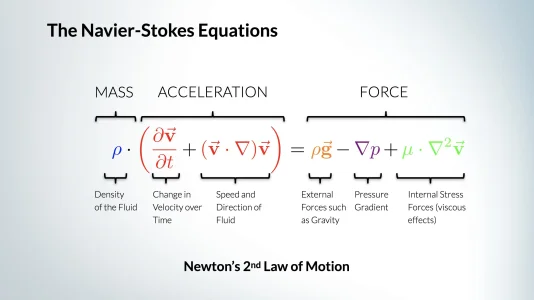
These are famous Navier -Stokes equations developed in the 1840s. If you can solve these equations analytically you will get a million dollar prize.
The above equation is the very basic needed to understand Advanced fluid mechanics.
now below we have written the same equation in simplified non-dimensional form.
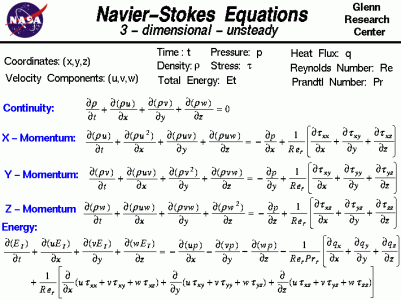
below is the basic 2 equation standard KE model used to numerically solve these equation.
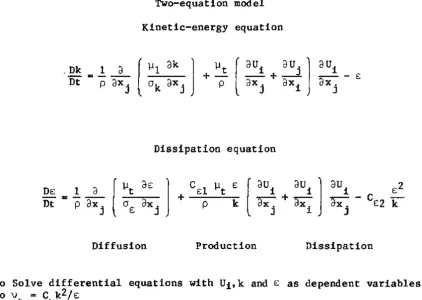
Many people in this forum do not have a technical background and forget about a degree in mechanical or electrical engineering, and you are asking to explain post graduate - level topics in detail.
I am not scaring anyone but if you can't understand these equations then you will never be able to understand the lift, drag, aerodynamics etc. The people who developed models to solve these equations are the current generation's best. Spallart who developed the spallart-allmaras model of turbulence works at Boeing. Menter who developed the SST K-omega model works at Ansys.
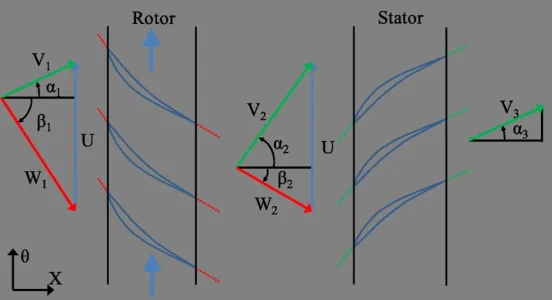
Above are the velocity triangles of an axial flow compressor with a rotor and stator. I don't even know if anyone can understand this or not.
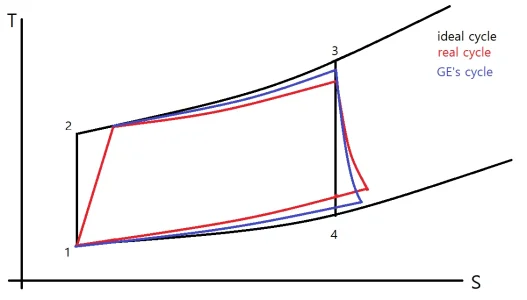
The above is a simplified cycle showing the difference between the ideal and actual Brayton cycle. You have no idea about Brayton cycle or the difference between the actual or ideal cycle.
You do not understand the concept of efficiency. I have explained to you the scientific definition of efficiency yet you decide to ignore that.
Total efficiency or overall efficiency does exist.
Efficiency overall = efficiency 1 X efficiency 2 X efficiency 3 ......................x efficiency n
for ex >>>
Brayton cycle or gas turbines are also used as stationary gas turbines for electricity generation on land.
The overall efficiency is = cycle efficiency X mechanical efficiency X generator efficiency
another example is when a gas turbine is used for a turboshaft or turboprop where output is given in kilowatts and you can easily calculate efficiency by dividing output power by input power.
Input power is the calorific value of the fuel.
Efficiency = shaft power / ( mass flow rate fuel X calorific value of fuel)
It's not that I don't like to teach people but I don't like to teach advanced concepts when people have no idea of basics.
And let me remind you my primary job is doing research and sometimes teaching PG students.
I will help anyone and provide guidance to those who want to learn advanced fluid mechanics, computational fluid dynamics, turbulence modelling, advanced engineering mathematics etc and I will share videos, codes, ebooks etc if someone needs them but in the end, people have to learn these topics themselves.
And sorry if my post sounds rude but sometime I do get irritated.
- Joined
- Jul 2, 2024
- Messages
- 934
- Likes
- 2,439
If 2 cities are say 800 Kms apart.But no pilot would be insane to exhaust all his fuel by going supersonic throughout the duration of his flight. Both supersonic flight with AB and even supercruise are fuel intensive though the latter is better because of more efficient consumption of fuel. Supercruise or not, supersonic flight will consume a lot more fuel than subsonic flight.
In aerodynamics, you can't have both speed and range at once, if you want very high speed then you will have to increase the burn rate of your propellent, but as you increase the burn rate of the propellant, you also greatly increase fuel consumption which in turn results in the onboard plane having less fuel and hence will carry less distance.
1) A subsonic jet takes X gallons/litres/Kg of fuel flying at 800Km/hr takes 1hr (Flight/Fuel-burn time).
X amount fuel burnt in 60mins. Fuel burning rate = X/60 per minute
2) If a SuCr jet with new secret engine flying at 1,600 Km/hr taking 30mins, burns same X amount of fuel but quicker, is it a bad thing?
X amount fuel burnt in 30mins. The fuel burning rate is 2(X/60) per minute.
Distance travelled by both jets is same 800 Km
Fuel consumed by both jets is same X.
Subsonic jet took TWICE time than SuCr jet.
The above is a theoretical example but scientists & engineers are working to get as close to it as possible. No engine is IDEAL, there are verious kinds of losses - thermal, mechanical, friction, sonic drag, etc.
We need to see the engine SFC data from credible source, figures or graph on fuel consumption at different speeds & altitudes.
We are not even talking about Afterburners. It is not part of Supercruise.One thing I don't know if everyone is aware of or not but the maximum ferry range of a fighter such as F-15, F-18, Rafale, F-35, F-22, F-16, Su-30 etc is only achievable in subsonic flight/mainly subsonic. Let's say that your plane is capable of going supersonic and you take off, and you immediately hit the afterburners, while you will cover a vast amount of distance in a short span of time, you will exhaust your fuel much more quicker than in subsonic flight.
As calculated & said earlier, F-35A's airframe T/W ratio with 50% fuel & IWB-AA load is 0.72 while that of F-22 is 0.92+The answer to whether the F-35 can/cannot supercruise is a topic of great debate.
So conclusion about the F-35's supercruise capabilities: One cannot say that the F-35 cannot super-cruise, it can but not as good as other planes which can maintain supercruise at higher mach speeds and longer durations as compared to F-35. So F-35 has Limited supercruise capabilities, not the absence of supercruise completely.
Its wing is shorter, with lower sweep angle, creates more drag. Its fuselage is a lifting body.
AMCA will be 12 tons empty, F-35A is 13.3 tons empty.
Fixing the wing will be enormous cost. All they can do is engine upgrade which they have started.
You missed my reply on Marketing.In my opinion, supercruise is really just a marketing term at least the mach value put forth by LM.
My definition of Supercruise would be this: Any aircraft that can sustain supersonic flight (Mach 1 or more) with a meaningful payload (in the case of fighter aircraft, this meaningful payload would be weapons such as missiles, bombs, targetting pods, sensors etc). I think the entire hue/fuss around supercruise is because of the definition set by LM that is misleading.
Fighter jet is also a product & part of global business. Who leads & dictates in business?
Evidently not. LM has been good at marketing techniques, but if F-22 @100% power can cover 527-642 Kms in 17-18 minutes with lowest engine & airframe SFC & no other jet can come close then it is not a marketing gimmick. Other jet makers, American & non-American, could be just jealous.Correct me if i'm wrong but wasn't super cruise just a marketing term for the F22,
If SC was SUSTAINED above 1.5 around 1.8 then...as it's supercruise was sustained above mach 1.5 and around 1.8?
F-22 can SuCr with IWB load. Whatever we are discussing in 2024, Boeing, General Dynamics, Grumman, Lockheed, Northrop, McDonnell Douglas, Rockwell & USAF discussed it in 1970s, that's 50 years back.




Jan 26, 1973 1st formal ATF requirements document issued
may 21, 1981 formal request for info issued to 9 companies
Nov 28, 1981 approval given to ATF program
Oct 31, 1986 construction begins of YF-22
(https://en.wikipedia.org/wiki/Advanced_Tactical_Fighter)
Check my previous post on Efficiency, Performance, Thrust, I/p -> Process -> O/pIf AMCA can cross mach 1 without the use of Afterburner (AB) with a decent payload then yes, AMCA can supercruise.
AMCA's supercruise ability depends on the AMCA's powerplant, let's see how that plays out. That said, its not necessarily the thrust that is the defining factor for supercruise, it's the efficiency of the engine which I believe falls significantly after Mach 0.9. I think AMCA Mk-1 will have better S-capabilities than the F-35, it will have limited supercruise capabilities while not completely none at all. MK-2 will have better S-capabilities surpassing both AMCA Mk-1 and F-35 JSF.
Please elaborate on this. What do you think about F-22 with GPS guided JDAM targetting SAM site?Even the F-22 doesn't have the range and desired payload capacity comparable to the F35 for SEAD missions.
Perhaps true for F-35 but depends on other SuCr jet referenced. We will need Cd, Fd, SFC data.Super cruising at any speed below Mach 1.4-1.5 is operationally useless. Better to travel at Mach .9 than Mach 1.1 -1.2 and increase drag and fuel consumption exponentially.
Only production military planes that can practicaly supercruise are F-22 and EF typhoon.
All other gripen,f-35,rafale,J20,Su 57 etc claiming to supercruise are nothing but marketing gimmicks.
There is nothing wrong touse reheat to cross sonic barrier & then SuCr, even in decent. It is not solution but work-around. Time & military will tell if usefull or useless.Most planes claiming to supercruise use reheat to cross sonic barrier then maintain super sonic speed with dry thrust alone, or sacrificing altitude, or super cruising at mach 1.1-1.2 .
All three methods will satisfy the definition of supercruise but will be operationally useless.
- Joined
- Jul 2, 2024
- Messages
- 934
- Likes
- 2,439
When we start studying at PG level, we have to do everything ourselves. In PhD, supervisors do not even provide resources, students have to do everything themselves.
CONGRATS Mr. POST GRAD + RESEARCH FELLOW + TEACHER !And let me remind you my primary job is doing research and sometimes teaching PG students.
YOU TRIED TO
> ACT LIKE SLEF-PROCLAIMED OTHERS' REPRESENTATIVE
> BUT INSULT EVERYONE'S CAPABILITY FORGETTING EVERYONE HAS SAME PCM TILL CLASS-10
> STALL THIS FORUM BY DISCOURAGING & CONTROLLING OTHERS
> FIND EXCUSE NOT TO SHARE BASIC INFO
> BUT PANIC PEOPLE BY GIVING COMPLEX MATHS
& IN THE PROCESS ACTUALLY INSULTED YOURSELF.


YOU KNOW EVERY MEMBER'S QUALIFICATION, PROFFESSION, EXPERIENCE, DESIGNATION?
THE SCIENCE OPTING STUDENTS WENT TO PET, KCET, IIT-JEE, COACHING CLASSES. WE ALL WERE TAUGHT SHORTCUTS TO SOLVE TRIGONOMETRIC, CALCULUS, MATRICES EQUATIONS IN EXAMS. SOME PREPARED FOR GATE, GRE, CAT/MAT, etc ALSO. TODAY WE DON'T NEED TO SOLVE THINGS ON PAPER BUT WE CAN UNDERSTAND THE FINAL EXPRESSION ANSWER - NUMERATOR & DENOMINATOR.
MANY MEMBERS have to manage office, house, family then find time to come here for time-pass. Like i said before, I only share & ask for basic calculations, graphs, diagrams & you are reacting as if someone demanded your kidneys, citing personal problems & excuses of time, motivation. You want to take personal responsibility to represent everyone? But you are preemptively doubting everybody's comprehension, qualification, experience.



A POST GRAD + RESEARCH FELLOW + TEACHER does not react like this.
Some of our college seniors joined back MTech, PhD & taught us. They were always cool with our querries. Where they didn't know they said it honestly.
I humbly introduced myself to be middle aged(40+), low IQ, senior IT engineer in role of system admin & tech support. I may not be PG/PhD holder but B.E. in Computers should be enough to discuss with M.Tech. DO YOU UNDERSTAND COMPUTER SCIENCE ENGINEERING SUBJECTS?
Today any person like me would naturally have every type & level of well qualified people in his/her social circle. But people with aeronautical interest are rare. For fear of troll nobody reveals their Linked-In & social media IDs.
So let me say this -
You could be Post Grad + teacher + Research fellow.
OR
You could be high school/college kid unable to give answers but panicking & copy-pasting hi-fi equations when asked for basic info, which all of us can copy paste.
Either ways, YOUR PRESENTATION, FORMAL COMMUNICATION, LEADERSHIP SKILLS ARE PATHETIC. YOU ASSUME TOO MUCH ABOUT OTHERS. STOP INSULTING & TRYING TO CONTROL OTHERS. IF YOU DON'T APPRECIATE US, WHY SHOULD WE APPRECIATE YOU?
DON'T ENDANGER REPUTATION OF THIS BRAND NEW WEBSITE.
OTHERWISE TELL ADMINS TO DELETE ALL R&D NEWS, EVERYTHING ABOVE MIDDLE SCHOOL LEVEL.

Detail doesn't mean straight up to level of highest level of hardcore maths, I never shared or asked for it.Brother, just relax.
I have told multiple times that I neither have time nor motivation to go into details.
Your time & motivation is your personal problem. Ignore & move on.
Forums contain people of all level, you cant stop anyone to discuss at a particular level.
Like i said, in every college, office also, people are tasked sometimes for presentations to audience, subjected to interaction.
Who asked you for all that? Sharing some basic parts from Wikipedia & Google Search means doing PG & PhD on this Forum?I can give you all the resources needed but you have to study them yourself.
Spoon feeding stops at UG level courses. When we start studying at PG level, we have to do everything ourselves. In PhD, supervisors do not even provide resources, students have to do everything themselves.
Higher-level study is all about independent work.

You 1st share basic calculations, graphs, diagrams, then we will tell you what we understood.
PRESENTATION SKILLS INCLUDE SIMPLIFICATIONAdvanced fluid mechanics is a subject that requires a high level of understanding of mathematics.
Below is the NS equation in incompressible, non-conservative form with the assumption that viscosity is constant.
View attachment 3086
These are famous Navier -Stokes equations developed in the 1840s. If you can solve these equations analytically you will get a million dollar prize.
The above equation is the very basic needed to understand Advanced fluid mechanics.
now below we have written the same equation in simplified non-dimensional form.
View attachment 3087
below is the basic 2 equation standard KE model used to numerically solve these equation.
View attachment 3093
So far you replied only GENERIC text with zero attachments, like typing from cellphone. It is only now you posted some info that too straight highest level of maths. You behave in extremities, either generic or hi-fi level.
I did not reply you with anything advanced & deep. Did you see me copy pasting OR asking you for the CALCULUS, MATRICES, HIGHER ORDER ALGEBRIC EQUATIONS part from Wikipedia, Google search? If you don't have capability to acertain other's level & maintain their level in a conversation then how do you manage a team? Leave team, how do you handle meeting people in any situation?
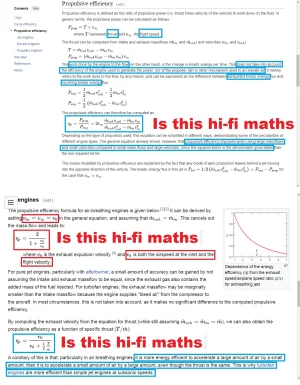
Gentle reminder - we are not people's representatives. Forums contain people of all age, qualification, experience. Everybody till class-10 learned basic PCM, calculus, vectors, etc.Many people in this forum do not have a technical background and forget about a degree in mechanical or electrical engineering, and you are asking to explain post graduate - level topics in detail.
You give your best what people ask. People can simply skip & ignore what they don't like or understand. They can even say that they don't get it, like i said i hate advanced PCM.
You are not scaring anyone. We all watch documentaries on TV & Youtube which mention such things. We simply ignore the hard parts.I am not scaring anyone but if you can't understand these equations then you will never be able to understand the lift, drag, aerodynamics etc. The people who developed models to solve these equations are the current generation's best. Spallart who developed the spallart-allmaras model of turbulence works at Boeing. Menter who developed the SST K-omega model works at Ansys.
This is easy to understand. 2D vectors was taught to everyone in Class 9/10. I have already seen this Velocity Triangle & mentioned about stator vane control few times.View attachment 3090
Above are the velocity triangles of an axial flow compressor with a rotor and stator. I don't even know if anyone can understand this or not.
- Stator vanes control as per speed
some engines like F-35's F-135 & f-22's F119 use more stage(s) of fixed exhaust vanes with secret ceramic-stealth alloys blocking the turbine blades & afterburner flame-holders.
Design for expansion (Turbine blades, exhaust vanes, Counter-rotating spools for air flow control, etc).
Similarly, changing not just BPR but also OPR(# of compressor/turbine stages), fuel type, fuel-air mix ratio, stator vane control, etc can change TIT, thrust, etc.
I have seen Youtube videos on air flow control by vanes also. The following video is much simpler.
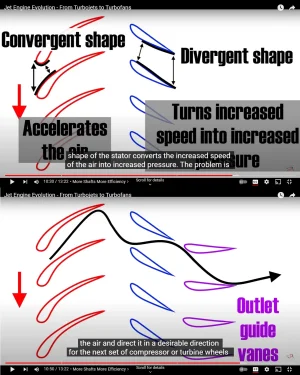
I know about the velocity triangle. I could have shared it.
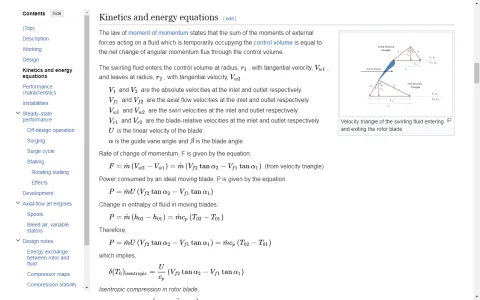
But you don't need to know if EVERYONE can understand, just the person(s) whom you are discussing with.
Science grads in school & engineering grads like me can attempt to understand what we like, if we like. You think only you understand terms like "isentropic", "isobaric", "adiabatic", etc?View attachment 3096
The above is a simplified cycle showing the difference between the ideal and actual Brayton cycle. You have no idea about Brayton cycle or the difference between the actual or ideal cycle.
I do understand the diagram above.
I saw many diagrams on wikipedia.
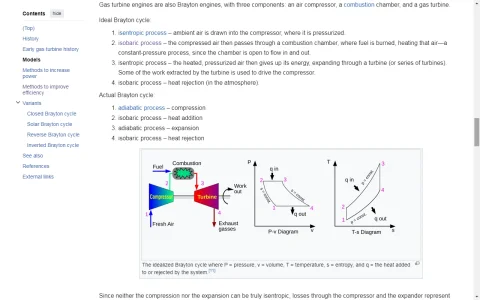
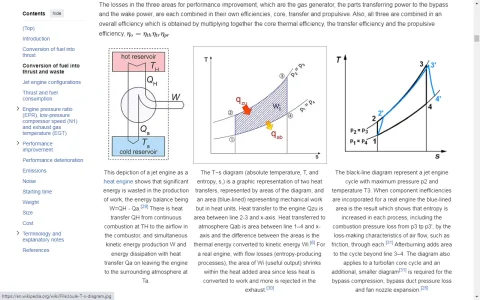
Where? When? Why don't you use "quote" functionality to remention if required?You do not understand the concept of efficiency. I have explained to you the scientific definition of efficiency yet you decide to ignore that.
We are not talking about stationary gas turbines for electricity generation on land.Total efficiency or overall efficiency does exist.
Efficiency overall = efficiency 1 X efficiency 2 X efficiency 3 ......................x efficiency n
for ex >>>
Brayton cycle or gas turbines are also used as stationary gas turbines for electricity generation on land.
The overall efficiency is = cycle efficiency X mechanical efficiency X generator efficiency
another example is when a gas turbine is used for a turboshaft or turboprop where output is given in kilowatts and you can easily calculate efficiency by dividing output power by input power.
Input power is the calorific value of the fuel.
Efficiency = shaft power / ( mass flow rate fuel X calorific value of fuel)
It's not that I don't like to teach people but I don't like to teach advanced concepts when people have no idea of basics.
We are not talking about Turbo prop
We are not talking about Turboshaft
Don't confuse people.
Mention the Efficiency equation or formula for low BPR military Turbofan, that's it.
Do you see any Defence enthusiasts channel talking about Efficiency (may be Tarmak Media House)? The following is a very short list. Now, I don't follow any channel strictly. But before covid-19 i had a huge list of websites - formal & casual.

WHO KNOWS WHAT YOU ARE BUT EITHER WAYS YOUR FORMAL COMMUNICATION SKILL IS PATHETIC.And let me remind you my primary job is doing research and sometimes teaching PG students.
And let me remind you AGAIN that since a decade now I am middle aged Sr. IT Engineer + SME + Project Trainer + Team Lead for UG+PG people. We are not R&D guys but out part is also important. Don't belittle others indirectly.
Today, there are many IIT+IIM or equivalent people. Everybody top to bottom including CEOs, CFOs, CIOs, CTOs, etc is expendable.
Depends on individual member. I don't need it.I will help anyone and provide guidance to those who want to learn advanced fluid mechanics, computational fluid dynamics, turbulence modelling, advanced engineering mathematics etc and I will share videos, codes, ebooks etc if someone needs them but in the end, people have to learn these topics themselves.
1st you share the minimum diagrams, graphs, specific basic specs, basic calculations, then we will see further.
That's your personal problem.And sorry if my post sounds rude but sometime I do get irritated.
You can refer to Communication trainers, Career Counselors.
You can attend seminars on Group discussion & Personal Interview.
You can watch Youtube videos also.
You can ask your trusted experienced people in your circle that with any kind of misbehavior you may get rejected in interviews or fired after being hired. Everywhere there are HR policies for code of conduct.
------------------------------------------------------------------------
We should continue to share what we know IN SIMPLIFIED WAY. Some will like, some will ignore, that's how forum works, nothing to worry about. But none of us should presume & misbehave with others.
Users who are viewing this thread
Total: 28 (members: 7, guests: 21)
Similar threads
Latest Replies
-
Indian Economy
- Doreamon
-
Israel x Iran Conflict
- liberalredditor
-
Jokes Thread
- The Juggernaut
-
Operation Sindoor & Aftermath
- Brood Father
-
Indian Air Force: News & Discussions
- redpanda
-
Indian Navy Developments & Discussions
- Nishaanbaaz

